3 Volumes
Culture: The Flavors of Philadelphia Life
Philadelphia began as a religious colony, a utopia if you will. But all religions were welcome, so Quakerism mainly persists in its effects on others, both locally and in America, in Art, clubs, and the way of life.
Philadelphia Since the Industrial Revolution
The Industrial Revolution began about the time America declared Independence. The young nation faced a clean slate and boundless opportunities.
Sociology: Philadelphia and the Quaker Colonies
The early Philadelphia had many faces, its people were varied and interesting; its history turbulent and of lasting importance.
Science
Science
Recording for the Blind and Dyslexic
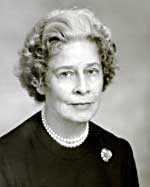
|
| Anne Mc Donald |
Anne T. Macdonald developed the idea in 1948 that a large number of blinded war veterans would benefit from recorded textbooks. Starting at the New York Public Library and now with a national headquarters in Princeton, a string of 29 centers have appeared across the nation, with an average of 7000 volunteers contributing their time reading textbooks into recording devices. The Philadelphia effort started at 36th and Market and has since moved to King of Prussia, where 280 volunteers read in teams of two, one inside the recording booth, and the other outside following the performance and stopping it for errors or muffled recordings. Since the effort specializes in technical textbooks, there is a constant search for specialists in particular technical fields. It is particularly important to understand the technical nature of the material when pronunciation is difficult, and when complicated graphs or illustrations need to be described for a blind audience. Originally, the material was produced on reels of tape but tends nowadays to concentrate on CDs and other disc recording devices.
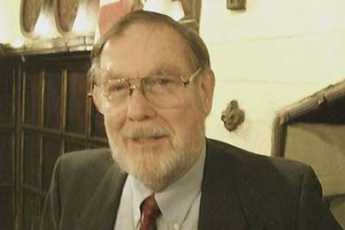
|
| Ralph Cohen |
Ralph Cohen, himself a volunteer reader, very kindly described the enterprise to an audience at the Right Angle Club of Philadelphia recently. It is particularly heartening to hear stories of blind persons receiving advanced technical degrees because of the availability of these recorded texts, even stories of those who rose from menial jobs to become engineers through this pathway.
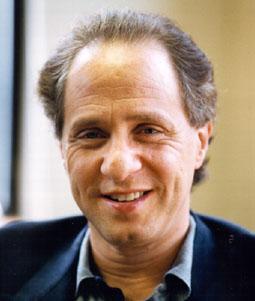
|
| Ray Kurzweil |
For those who have a particular interest in the topic, a few facts are important to know. Volunteers in technical fields are particularly needed, with two-hour recording slots extending over a relatively long time until a text is completed. Contributed money is needed in order to buy equipment and house it in a soundproof environment. Because of concern about copyright infringement, it is necessary to insist that the recorded products are only available to members of the reader's group, each one certified to be in need of such material because of a physical handicap. There is a fee of $65 to enroll, with $35 annual dues.
An interesting sidelight on reading difficulties emerges from the fact that most people who need help can see perfectly well. The disorder of dyslexia is so widespread that probably a majority of the population has at least a trace of it. The underlying problem with dyslexia lies in the brain, not in the eyes. The most common variant is to invert the sequence of words or letters, making such people utterly unable to record or remember a telephone number in the correct sequence. Often, psychological difficulties follow, as impatient siblings and acquaintances describe the victims as "stupid", a slur they often come to believe, themselves. A learning difficulty leads to a lack of learning, and the deficit becomes a real one. To the degree that these Recordings for the Blind and Dyslexic allow some to conquer their handicaps gives hope to others. One can even hope to see the whole matter unwind into a revision of the educational process, leading to a better and more prosperous society.
By an interesting coincidence, 1948 was the year Ray Kurzweil was born in Brooklyn. Developing an early interest in computers, his name is now associated with synthetic speech and voice recognition technology, and he has even branched out into music synthesis. He's a visionary, all right, and a promoter. If voice transcription gets tweaked just a little more, it is going to replace dictaphones and secretaries by the hundreds of thousands. No doubt Kurzweil is destined to become very rich if indeed he is not already so. It's thus a little startling to encounter him as a professional entertainer on the lecture circuit, apparently driven relentlessly by a need to be appreciated. If that's what he needs, let's give it to him. The transformation of half of our society seems within his grasp. And in many ways his success is based on the flash of insight that dyslexic people are not stupid; in fact, maybe no one is. We all walk around with computers in our skull, and computers are always full of bugs. No doubt it should be said of brains, as it is of computer programs, that one has never been created that did not contain many "bugs". The important issue is not whether the computer is defective, but whether it somehow mobilizes the effort to overcome its defects.
WWW.Philadelphia-Reflections.com/blog/1182.htm
Native Habitat
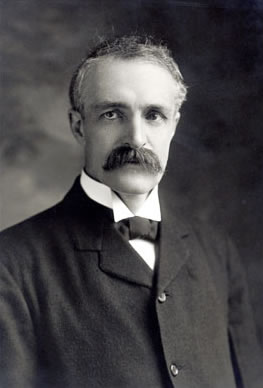
|
| Gifford Pinchot |
Teddy Roosevelt's friend Gifford Pinchot is credited with starting the nature preservation movement. He became a member of the Governor's cabinet in Pennsylvania, so Pennsylvania has long been a leader in the formation of volunteer organizations to help the cause. Sometimes the best approach is to protect the environment, letting natural forces encourage the growth of butterflies and bears in a situation favorable to them. Sometimes the approach preferred has been to pass laws protecting threatened species, like the eagle or the snail darter. Sometimes education is the tool; the more people hear of these things, the more they will be enticed to assist local efforts. The direction that Derek Stedman of Chadds Ford has taken is to help organize the Habitat Resource Network of Southeast Pennsylvania.

|
| butterfly |
The thought process here is indirect and gentle, but sophisticated; one might call it typically Quaker. Volunteers are urged to create a little natural habitat in their own backyards, planting and protecting plant life of the sort found in America before the European migration. If you wait, some insects which particularly favor the antique plants in your garden will make a re-appearance, and in time higher orders like birds that particularly favor those insects, will appear. The process of watching this evolution in your own backyard can be very gratifying. To stimulate such habitats, a process of conferring Natural Habitat certification has been created. In our region, there are over three thousand certified habitats.
Of course, you have to know what you are doing. Provoking people to learn more about natural processes is the whole idea. For example, milkweed. That lowly weed is the source of the only food Monarch butterflies will eat, so if you want butterflies, you want milkweed. For some reason, perhaps this one, the Monarch is repugnant to birds, so Monarchs tend to flourish once you get them started. After which, of course, they have their strange annual migration to a particular mountain in Mexico. Perhaps milkweed has something to do with that.
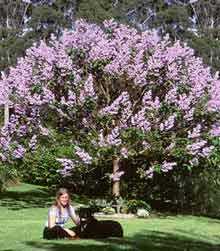
|
| Empress tree |
If you plant trees and shrubs along the bank of a stream, the shade will cool the water. That attracts certain insects, which attract certain fish. If you want to fish, plant trees. And then we veer off into defending against enemies. The banks of the Schuylkill from Grey's Ferry to the Airport are lined with oriental Empress trees, with quite pretty purple blossoms in the Spring. These trees seem to date from the early 19th Century trade in porcelain (dishes of "China" ) on sailing vessels. The dishes were packed in the discarded husks of the fruit of the Empress tree, and after unpacking, floated down the Schuylkill until some of them sprouted and took root. Empress trees are certainly an improvement over the auto junkyards hidden behind them. On the other hand, Kudzu is an oriental plant that somehow got transported here, and loved what it found in our swamplands. Everywhere you look, from Louisiana to Maine, the shoreline grasslands are a sea of towering Kudzu, green in the spring, yellow in the fall. It may have been an interesting visitor at one time, nowadays it's a noxious weed. So far at least, no animals have developed a taste for Kudzu, and no one has figured out a commercial use for it. When an invasive plant of this sort gets introduced, native habitat and its dependent animal life quickly disappear. So, in this situation, nature preservation takes the form of destroying the invader.
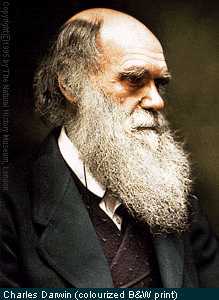
|
| Charles Darwin |
But where is Charles Darwin in all this? The survival of the fittest would suggest that successful aggressors are generally fitter, so evolution favors the victor. Perhaps swamps are somehow better for being dominated by Kudzu, pollination might be enhanced by killer bees. At first, it might seem so, but if the climate or the environment is destined to be in constantly cycling flux, diversity of species is the characteristic most highly desired. For decades, biologists have puzzled over the surprising speed of adaptation to environmental change. Mutations and minor changes in species seem to be occurring constantly, and most of them are unsuccessful changes. But when ocean currents change, or global warming occurs, or even man-made changes in the environment alter the rules, we hope somewhere a favorable modification of some species has already occurred standing ready to take advantage of the changing environment. Total eradication of species variants, even by other species which are temporarily better adapted, is undesirable. In this view, the preservation of previously successful but now struggling species is a highly worthy project. The meek, so to speak, will someday have their turn, will someday inherit the earth. For a while.
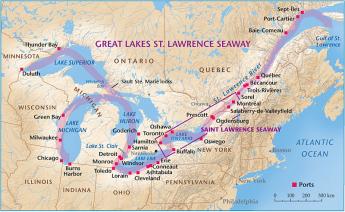
|
| St. Lawrence Seaway map |
And finally, there are variants of the human species to consider. To be completely satisfying, a commitment to preserving "native" species in the face of aggressive new invaders must apply to our own species. Surely, a devotion to preserving little plants and insects against the relentless flux of the environment does not support a doctrine of driving out Mexican and Chinese immigrants at the first sign of their appearance, like those aggressive Asian eels plaguing the St. Lawrence Seaway?. Here, the answer is yes, and no. For the most part, invasive species are aggressive mainly because they find themselves in an environment which contains no natural enemies. If that is the case, fitting the newcomers into a peaceful equilibrium is a matter of restraining their initial invasion long enough for balance to be restored through the inevitable appearance of natural enemies. So, if we apply our little nature lessons to social and economic issues related to foreign immigration, the goal becomes one of restraining an initial influx to a number which can be comfortably integrated with native tribes and clans. In the meantime, we enjoy the hybrid vigor which flourishes from exposure to new ideas and customs.
In the medium time period, that is. For the long haul, if the immigrant tribes really do have -- not merely a numerical superiority -- a genetic superiority for this environment, perhaps we natives will just have to resign ourselves to retreating into caves.
WWW.Philadelphia-Reflections.com/blog/1219.htm
Big Pharma Loses Momentum
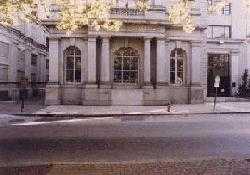
|
| Chemical Heritage Building |
listened to the analysis by G. Steven Burrill, a noted venture capitalist who specializes in this area. The big firms, like Merck, Wyeth, Johnson and Johnson have recently reported disappointing earnings, and it seems they have been reducing their American research divisions, with more use of small niche research firms as subcontractors, both American and foreign. As they tend to reduce their emphasis on research and manufacturing, Steve Burrill feels they will concentrate mainly on marketing. That sounds like good news for Wyeth, with its traditional focus on marketing, and bad news for Merck, which has always been strong in new product development.
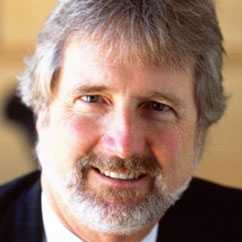
|
| G. Steven Burrill |
Burrill also has his eye on the statistic that only 8% of health care spending is devoted to pharmaceuticals, while 40% is spent on nostrums to promote wellness. The sly observation slipped out that if 40% of health spending goes for products of questionable value, just think how big the market would be for new products that really do promote some wellness. So that, in his opinion, is where investors will prosper.
Some of us in the back of the room were troubled by these thoughts. In the first place, the major drug houses have long operated with a financial business plan that takes profits from old established drugs and uses them to pay for research on the new drugs of the future. Small niche companies, that only work on one phase of this cycle, have had difficulty financing expansion and mostly accepted a subsidiary role. You might develop a wonder drug in your garage, but you had to license it to a big pharma concern in order to thrive. The thought pops up that the protracted wait for

|
| PA Drug Industry |
Food and Drug approval might be stretching the old-drug/new-drug interval to the point where patent expiration on the current revenue generators interrupts the internal recycling of profits into new drug research. That's been a threat ever since the passage of the Kefauver Amendment, but a new twist has appeared in the form of a tidal wave of cheap liquidity from the Far East, working its way into venture capital pools and assisting the niche firms with their historical shortages of capital. If that's a significant feature of the present environment, it could fizzle out when the Far East stops pumping liquidity into world markets. A new Premier of Japan might be all it would take, or else a drop in the price of oil. Japan's interest rates are now held below 1%, while a realistic price for oil is $45 a barrel, not $65.
And as far as the promotion of wellness is concerned, that concept might just turn out to be a fad. Congress doesn't try to evaluate scientific trends, but it is very fond of insisting that "if it ain't broke, don't fix it". A major advance in the treatment of cancer and or Alzheimer's Disease might very well dampen Congressional enthusiasm for spending 15% of Gross Domestic Product on what's then left to treat, which would mostly be wellness.
Venturi's Franklin Museum in Franklin Court
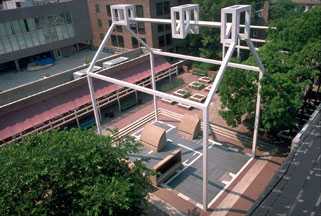
|
| Franklin Court Museum |
When Judge Edwin O. Lewis was seized with the idea of making a national monument out of Colonial Philadelphia, he wanted it big. Forty or so years later, it's big all right, but not big enough to encompass the whole of America's most historic square mile. Government ownership in the form of a cross now extends five blocks north from Washington Square to Franklin Square, and four blocks East from Sixth to Second Streets. Restoration and historic display have spread considerably beyond that cross, however, and the Park Service has created ingenious walkways within the working city in the neighborhood. If you thread your way through these walkways, you can stroll for miles within the world of William Penn and Benjamin Franklin. One such unexpected walkway is now called Franklin Court, which essentially cuts from Market to Chestnut Streets, within the block bounded by 3rd and 4th Streets. Hidden in the center is the reconstructed ghost of Franklin's quite large house, sitting in an interior courtyard bounded by a colonial post office, and a newspaper office once operated by Franklin's grandson. And, along the side of the walkway near Chestnut Street, is a fascinating museum of Franklin's personal life, built by no less than Frank Venturi, and operated by Park Rangers in the polished but low-key manner for which the U.S. Park Service is famous.
For some reason, this jewel of a museum has not received the high-powered publicity it deserves. It's off the main Park premises, as we mentioned, and some of the problem has to be attributed to Venturi. As you walk through, you don't expect a huge museum to be there, and it can look pretty inconspicuous as you walk past because it is mostly underground. Take my word for it, it's worth a visit. There are long descending ramps inside the doors, which can be pretty daunting if you are elderly and tired. But, also inconspicuous, there's an elevator if you look around for it. Venturi didn't seem to like windows very much, which is a problem for some people.
There's a movie theater inside there, playing a long list of fascinating documentaries. There's an ingenious automated display of statuettes which utilize spotlights and revolving stages to present Franklin in Parliament, resisting the Stamp Act, Franklin being his charming self before the French monarchs, and the frail dying Franklin getting the Constitutional Convention to approve the document. There are also a variety of ingenious inventions of Franklin's on display in the original, including bifocal glasses, the first storage battery, a simplified clock, several library devices, the Franklin stove, and so on. In some ways, the highlight is the Armonica.
The Armonica is the musical instrument invented by Franklin, for which both Beethoven and Mozart composed special music to exploit its haunting tone. If you ask the nice Park Ranger, she will be flattered to play you a tune on it.
Armonica, Momentarily Mesmerizing
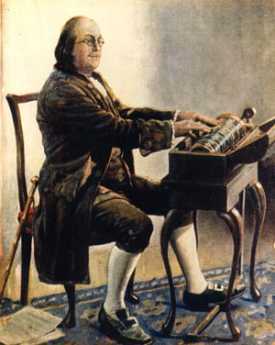
|
| Ben Franklin's Glass Armonica |
Everyone knows Ben Franklin spent a lot of time holding a wine glass. Evidently, he noticed a musical note emerges if you run your finger around the open mouth of the drinking glass, and systematically studied how the tone can be varied by varying the level of liquid in the glass. The same variation in emitted tone relates to variations in the thickness of the glass. So, he set up a series of different sized glasses impaled on a horizontal broomstick, enough to cover three octaves, rotated the broomstick with a treadle like those used for spinning wheels -- and made music. The tone has a haunting penetration to it, which induced both Beethoven and Mozart to write special compositions for the harmonica, and the Eighteenth Century went wild with enthusiasm.
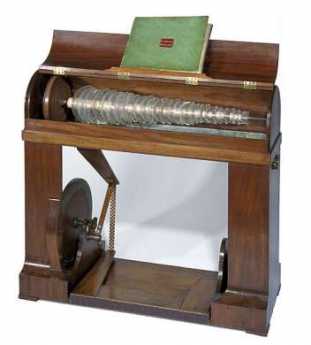
|
| Glass Armonica |
Unfortunately, a number of the young ladies who played the armonica went mad. We now recognize that since the finest crystal glass was used, with very high lead content, the mad ladies were suffering from lead poisoning after repeatedly wetting their fingers on their tongues. As a matter of fact, port wine at that time was stored in lead-lined casks, resulting in the same unfortunate consequences, which included stirring up attacks of gout. Franklin himself was a famous sufferer from gout, which was more likely related to the port wine than playing the harmonica, in his particular case.
Anyway, the reputation for inducing madness added to the spooky sort of sound the instrument made, attracting the attention of a montebank named Franz Anton Mesmer, who falsely claimed to be the father of hypnotism. Mesmer enhanced the society of his stage performances by hypnotizing subjects while an assistant played the harmonica, meanwhile relating all sorts of wild tales about animal magnetism. This was pretty sensational at the time until a young man in an audience suddenly died. It is now speculated that the victim probably had an epileptic seizure, but the news of this public fatal event pretty well finished Mesmer as an evangelist and the harmonica as a musical instrument.
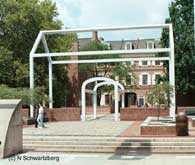
|
| Franklin Court |
There's a replica of an armonica on display in the Franklin Court Museum around 3rd and Chestnut, which we are vigorously assured is not made with leaded crystal glass. The Park Rangers put on two daily performances by request, at noon, and 2:30 PM.
Quakerism and the Industrial Revolution
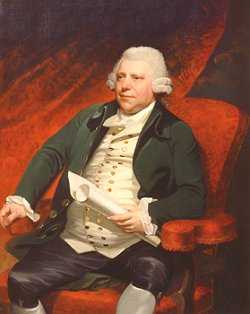
|
| Richard Arkwright |
The Industrial Revolution had a lot to do with manufacturing cotton cloth by religious dissenters in the neighborhood of Manchester, England in the Eighteenth Century. What needs more emphasis is the remarkable fact that Quakerism and the Industrial Revolution both originated about the same time, in about the same place. True, the industrializing transformation can be seen in England as early as 1650 and as late as 1880. The Industrial Revolution thus extended before Quakerism was even founded, as well as long after most Quakers had migrated to America. No Quaker names are much mentioned except perhaps for Barclay and Lloyd in banking and insurance, and Cadbury in candy. As far as local history in England's industrial midlands is concerned, the name mentioned most is Richard Arkwright, whose behavior, demeanor and beliefs were anything but Quaker.
He seems to have invented nothing, stealing the patents and ideas of others freely, while disgustingly boasting about his rise from rags to riches. Some would say his skill was in the organization, others would say he imposed an industrial dictatorship on a reluctant agricultural community. He grew rich by coercing orphans, convicts and others he obviously disdained into long, unpleasant, boring and unwelcome labor that largely benefited him, not them. In the course of his strivings, he probably forced Communism to be invented. It is no accident that Karl Marx wrote the Communist Manifesto while in Manchester visiting his friend Friedrich Engels, representing reasonably well the probable attitudes of Arkwright's employees. What Arkwright recognized and focused on was that enormous profits could flow from bringing piecework weaving into factories where machines could do most of the work. Until his time, clothing was mostly made by piecework at home, with middlemen bringing it all together. The trick was to make clothing cheaper by making a lot of it, and making a bigger profit from a lot of small profits. Since the main problem was that peasants intensely disliked indoor confinement around dangerous machines, the industrial revolution in the eyes of Arkwright and his ilk translated into devising ways to tame such semi-wild animals into submission. For their own good.
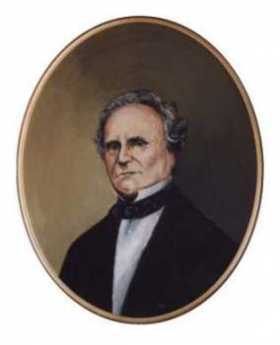
|
| Charles Babbage |
Distinctive among the numerous religious dissenters in the region, the Quakers taught that it was an enjoyable experience to sit indoors in quiet contemplation. Their children were taught to submit to it at an early age, and their elders frequently exclaimed that it was a blessing when everyone remained quiet, enjoying the silence. Out of the multitude of religious dissenters in the first half of the Seventeenth century, three main groups eventually emerged, the Quakers, the Presbyterians, and the Baptists. Only the Quakers taught that silence was productive and enjoyable; the Calvinist sects leaned toward the idea that sitting on hard English oak was good for the soul, training, and discipline was what kept 'em in line.
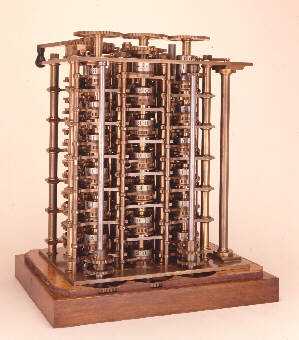
|
| babbagemaq.jpg |
The Quaker idea of fun through daydreaming was peculiarly suitable for the other important feature of the Industrial Revolution that Arkwright and his type were too money-centered to perceive. If workers in a factory were accustomed to sit for hours, thinking about their situation, someone among them was bound to imagine some small improvement to make life more bearable. If such a person was encouraged by example to stand up and announce his insight, eventually the better insights would be adopted for the benefit of all. Two centuries later, the Japanese would call this process one of continuous quality improvement from within the Virtuous Circle. In other cultures, academics now win professional esteem by discovering "win-win behavior", which displaces the zero-sum or win/lose route to success. The novel insight here was that it has become demonstrably possible to prosper without diminishing the prosperity of others. In addition, it was particularly fortunate that many Quaker inhabitants of the Manchester region happened to be watchmakers, or artisans of similar trades that easily evolved into the central facilitators of the new revolution -- becoming inventors, machine makers and engineers.
The power of this whole process was relentless, far from limited to cotton weaving. When Charles Babbage sufficiently contemplated the punched-cards carrying the simple instructions of the knitting machines, he made an intellectual leap to the underlying concept of the tabulating machine. Using what was later called IBM cards, he had the forerunner of the stored-program computer. There were plenty of Arkwrights getting rich in the meantime, and plenty of Marxists stirring up rebellion with the slogan that behind every great fortune is a great crime. But the quiet folk were steadily pushing ahead, relentlessly refining the industrial process through a belief in welcoming the suggestions of everyone.
Baruch Blumberg, Renaissance Man

|
| College of Physicians |
Baruch Blumberg may be an octogenarian, but he radiates vigor and good health; his current intellectual interests are invariably on the cutting edge. He currently serves as the president of the American Philosophical Society, was for five years the Master of Balliol College at Oxford, was the Director of Astrobiology at NASA -- all of them after he had won the Nobel Prize in Medicine, and retired from his laboratory. He likes to run and bicycle, with a long history of disconcerting the populace of China, India, and Africa with early morning forays. His undergraduate major was physics, with graduate work in mathematics. He went to medical school at his father's suggestion.
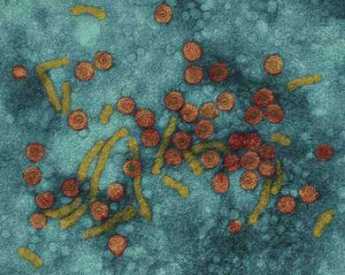
|
| Hepatitis B |
The Nobel Prize was awarded for the discovery of the Hepatitis B virus, for which he developed a highly successful vaccine. It has been estimated that there are 375 million people in the world infected with this virus, and it leads in time to liver cancer, the most common form of cancer in Asia. If you set about to stamp out disease and save lives, it's advantageous to do it with an extremely prevalent disease. And then there are some surprising side-benefits. For some reason, women who are infected with Hepatitis B produce a disproportionately large number of male offspring, so that vast immunization programs in Asia are now starting to result in a larger proportion of females in the population. The lack of female children in Asian families has long been attributed to selective abortion, so it's satisfying to see an abatement of that particular slander.
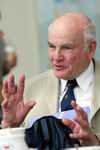
|
| Baruch Blumberg |
Blumberg has twice been invited to deliver a lecture to the College of Physicians of Philadelphia. The first was a description of the problems of space travel. The second was a discussion of current trends in medical genetics. It seems that gene mutations only occasionally cause disease directly. The much more important genetic factor in disease affects the ability of some people to resist particular diseases and makes others more likely to be a victim. Hepatitis B? Well, that's so yesterday.
Valentine Tours, Right Here in River City
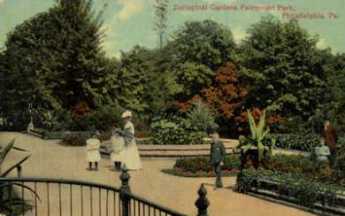
|
| Zoo Opening |
The Philadelphia Zoo claims to be the oldest zoo in America, although New York's Central Park Zoo is older. The explanation for this puzzle is that the Philadelphia Zoo was chartered by the legislature in 1859, but its opening was delayed by the Civil War until 1874. Meanwhile, the Central Park Zoo was opened in 1862. One hopes the true priorities are perfectly clear, although the Romans had zoos, and Montezuma had a spectacularly big one when Cortes arrived. Why all this wandering prologue before a discussion of a Valentine Tour? Well, since the internet is so plagued by a dispute about what is suitable for children to read, it is not clear that our Zoo's legitimate activities would escape hostile robot detection, banishment by Google, or the like if we talk about them on this website. So we will be indirect.
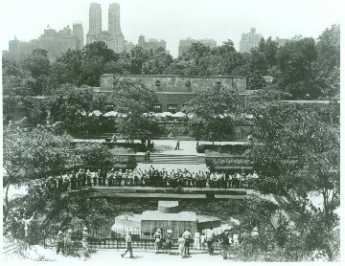
|
| Central Park NYC |
It is related that it was the women's committee of the zoo who first proposed an adult zoo camp which now goes by the name of Valentine Tours. For a modest fee of $75, it is possible to join this activity, involving discussions and demonstrations of the varieties and complexities of vertebrate reproduction. It is not only the Philadelphia public which needs education in these matters. One of the main sources of infertility among rhinos and gorillas derives from the surprising fact that they must be taught what to do. Apparently, when removed from the voyeur opportunities of their native environment, these monsters can't figure out what is expected of them.
John Bernard, a docent at the zoo for 18 years, has written a book about the varieties of romantic experiences and recently addressed the Right Angle Club on the matter. He tells of four-footers and hundred-pounders, and the like. Apparently, male elephants make their ladies wait in line for their turn, male gorillas have several girlfriends at all times, and male lions are so occupied with demands made on them that they scarcely do anything else. Bats cavort upside down, eagles lock claws and fall out of the sky, polar bears starve for months afterward. The fascination just goes on and on.
The inside details of some recent events are also revealed. Male African elephants go into a variant of heat that lasts three months and makes them dangerous to be around. That's really why the zoo recently decided to get rid of its elephant collection. Orangutans will rape a female zoo employee if given a chance. The Women's Committee of the Zoo is certainly to be thanked for alerting us. For more details, stump up the $75 and take a Valentine Tour.
Fernery
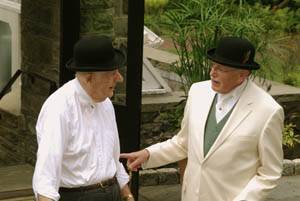
|
| Gardeners |
As explained by the curator of The Morris Arboretum, there are a few other ferneries in the world, but the Morris has the only Victorian fernery still in existence in North America. That doesn't count a few shops that sell ferns and call themselves ferneries; we're talking about the rich man's expensive hobby of collecting rare examples of the fern family in an elaborate structure. That's called a Victorian fernery. The one we have in our neighborhood is really pretty interesting; worth a trip to Chestnut Hill to see it.
Although our fernery was first built by the siblings John and Lydia Morris, it was rebuilt at truly substantial cost by the philanthropist Dorrance Hamilton. It is partly above ground as a sort of greenhouse, and partly below ground, with goldfish and bridges over its pond. Maintaining an even temperature is accomplished by a complicated arrangement of heating pipes. The temperature the gardener chooses affects both the heating bill and the species of fern that will thrive there. You could go for 90 degrees, but practical considerations led to the choice of 58 degrees. The prevailing humidity will affect whether the fern reproduction is sexual or asexual, a source of great excitement in 1840, but survivors of Haight-Asbury are often more complacent on the humidity point.
There are little ferns, big ferns, tree ferns, green ferns, and not-so-green ferns; the known extent of ferns runs to around five hundred species. Not all of them can be found in Chestnut Hill, what with humidity and all, but there are enough to make a very attractive and interesting display. For botanists, this is a must-see exhibit. For the rest of us, it's probably the only one of its kind we will ever see, a jewel in Philadelphia's crown, and shame on you if you pass it by.
Morris Arboretum
 The former estate of John and Lydia Morris is run as a public arboretum, one of the finest in North America. 
|
Morris is the commonest Philadelphia name in the Social Register, derived largely from two unrelated Colonial families. In addition to their city mansions, both families had country estates. The country estate once belonging to the Revolutionary banker Robert Morris was Lemon Hill, just next to the Art Museum, where Fairmount Park begins. But way up at the far end of the Park, beyond Chestnut Hill, was Compton, the summer house of John and his sister Lydia Morris. This Morris family had made a fortune in iron and steel manufacture and were firmly Quaker. Both John Morris and his sister were interested in botany and had evidently decided to leave Compton to the Philadelphia Museum of Art as a public arboretum. John died first, leaving final decisions to Lydia. As the story is now related, Lydia had a heated discussion with Fiske Kimball, at the end of which the Art Museum deal was off. She turned to her neighbor Thomas Sovereign Gates for advice, and the arboretum is now spoken of as the Morris Arboretum of the University of Pennsylvania. It is also the official arboretum of the State of Pennsylvania. To be precise, the Morris Arboretum is a free-standing trust administered by the University, with the effect that five trustees provide legal assurance that the property will be managed in a way the Morrises would have wished. In Quaker parlance, Lydia possessed "steely meekness."
A public arboretum is sort of an outdoor museum of trees, bushes, and flowers, with an indirect consequence that many museum visitors take home ideas for their own gardens. Local commercial nurseries tend to learn here what is popular and what grows well in the region, so there emerges an informal collective vision of what is fashionable, scalable, and growable, with the many gardeners in the region interacting in a huge botanical conversation. The Morris Arboretum and two or three others like it go a step further. There are two regions of the world, Anatolia and China-Korea-Japan, with much the same latitude and climate as the East Coast of America. Expeditions have gone back and forth between these regions for a century, transporting novel and particularly hardy or disease-resistant specimens. An especially useful feature is that Japan and parts of Korea were never covered with glaciers, hence have many species found nowhere else in the temperate zone. Hybrids are developed among similar species found on different continents, and variants are found which particularly attract or repel the insects characteristic of each region. The Morris Arboretum is thus at the center of a worldwide mixture of horticulture and stylish outdoor fashion, affecting millions of home gardeners who may never have heard of the place.
The University Museum: Frozen in Concrete
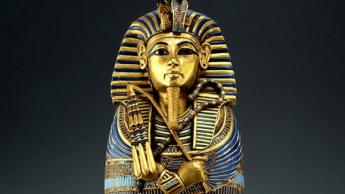
|
| King Tut |
Recently, a charming archeology scholar from the University of Pennsylvania, Leslie Ann Warden, entertained the Right Angle Club with the interesting history of King Tut. Interest in this subject is currently heightened by a traveling exhibit of the tomb relics currently on elegant display at the Franklin Institute. However, Philadelphia also has a permanent exhibition of Egyptian artefacts lodged in the University Museum. Since this museum is the second largest archaeology museum in the world, after the British Museum, that makes it the largest in America. An interesting sidelight is that Ms. Warden spoke in the grill room of the Racquet Club, which was the first effort by William Mercer to use "Mercer" tiles in a building. Mercer at that time was the curator of the University Museum. We learned from Ms. Warden that King Tutankhamen was unknown before his tomb was discovered, all records of this part of the Egyptian dynasty having been lost or deliberately obliterated by successors. Therefore, the discovery of these magnificent art objects started a massive expansion of scholarship about the entire Third Millenium.
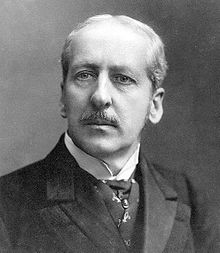
|
| William Pepper |
The establishment of the University Museum around 1890 was apparently mostly due to the enthusiasm of William Pepper, then Provost of the University of Pennsylvania. What seems to have got Pepper going was an expedition to Iraq, the place where civilization began, in Mesopotamia. The relics brought back from this celebrated effort needed a home, and Pepper decided it had to be here. One famous philanthropist after another, often in the role of Chairman of the Board of Trustees, carried on the tradition after Pepper's premature death. Some of them have their names on buildings, some declined. To a notable degree, the feeling of special possession was exemplified by Alexander Stirling Calder, who turned the statues in the garden to face inward rather than out toward the street. Asked whether a mistake had been made, he is said to have replied that due to the Museum's withdrawn character, it was more appropriate for the world to face the Museum. No more icily accurate comment has ever been made about the University's relation to its city neighbors.
The real knock about the Museum is that too much has been crowded into too little real estate, and the fault lies with the automobile. After the University outgrew its space at 9th and Market around 1870, moving then to West Philadelphia, the architects and the donors originally envisioned a grand boulevard of culture stretching from the South Street bridge many blocks westward. The Museum, Franklin Field, Irvine Auditorium, The University Hospital were to be the start of an imposing array of culture. Unfortunately, that was a horse-drawn conception, soon to be overwhelmed by the worst traffic jam in the city. The Schuylkill Expressway was the final blow, setting huge auto-oriented structures in place where their easy removal became difficult to imagine. The 1929 stock crash, followed by confiscatory income and estate tax rates, merely emphasized the plain fact that restoring the grand vision was beyond the ordinary aspirations of even massive private wealth. Transforming the imposing plazas of the University Museum into parking garages was probably a result of excessive despair, but if you have ever tried to find a place to park in that region you can somewhat sympathize with the small-mindedness which prompted it. Bringing back this region is going to require immense vision and resources, neither of which is exactly thrusting itself forward at present. So, unfortunately, one of the central cultural jewels of the City is buried in the midst of an impenetrable thicket of concrete and speeding automobiles, too big to move, too small to burst its bonds.
It's well worth a lot of anybody's time, and many visits. If you can find a way to get there.
Tree Huggers: Delaware Valley College
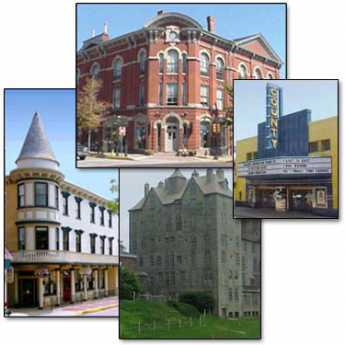
|
| Doylestown, PA |
At the time when Philadelphia and New York were both occupied by the British during the Revolutionary War, a backwoods highway connected the thirteen colonies. Doylestown is 35 miles due north of Philadelphia City Hall, at the point of intersection of this variant of the Ho Chi Minh Trail with the path which Philadelphia Tories took in their flight to Kingston, Ontario. No doubt there were some interesting conversations in Mr. Doyle's tavern at the crossroads.
Doylestown is also on the invisible border between the hegemonies of Philadelphia and New York, where descendants of German and Quaker farmers make a cautious contact with the distinctly non-Quaker artists and writers fleeing south from New York. James Michener and Pearl Buck once represented Philadelphia in the cultural stew with New Yorker ex-patriots, Somehow in this interface, a place is found for the Delaware Valley College, which started life in 1896 with Jewish founders of the National Farm School. The original board of trustees included such names as Gimbel, Lit, Snellenburg, and Erlanger, but the three-year curriculum was entirely agricultural. The founder himself was Joseph Krauskopf, who got the idea after an inspiring interview with Count Leo Tolstoy.
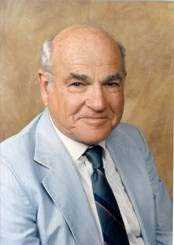
|
| Baruch Blumberg |
From a single building which served as classroom and dormitory, the college has grown into a four-year institution in numerous buildings scattered over a 570-acre plot with a second 120-acre farm in Montgomery County. The school is determinedly non-sectarian, and for forty years has been coeducational. It has had several changes of name, from the National Farm School, eventually to its present name. The curriculum has expanded as well, with masters degree programs in business and education. Baruch Blumberg, the Nobel Prize winner in Medicine, maintains an office there, and it is clear the college means to shift its emphasis toward the scientific basis of agriculture and the environment. It's also pretty clear that rising agricultural prices will soon re-establish agriculture as a dominant feature of our economy, although agriculture in the modern sense is quite a distance from farming in the old sense, and requires a different sort of educational preparation.
The Right Angle Club of Philadelphia recently heard from Joshua Feldstein the chairman of the board of trustees, and the brand-new president, just moving in from Columbia University. Sixty-eight years of driving ambition is personified in one, and the bright shining future in the other. We wish them well.
By the way, the tree hugger nickname comes from a campus tradition of this college, very much an active ceremony, of hugging the 400-year-old oak standing beside the president's house on the campus. The College, of course, is 250 years younger than the tree.
WWW.Philadelphia-Reflections.com/blog/1295.htm
Exit, Pursued by a Bear
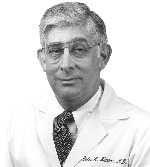
|
| John Kastor |
Everybody ends up getting fired in a recent book by John Kastor about recent events at the University of Pennsylvania just like everybody ending up dead in an Elizabethan play. The vital difference, of course, is that the dramatis personae at Penn can still relate to a bewildered audience their own versions of those grand events. To protect himself, the author peppers his book with more footnotes than a Ph.D. thesis. And thousands of stakeholders at the University can now realize that during those eventful times they were as clueless as Rosencranz and Guildenstern.
One basic fact about that institution is that the medical school spends three-quarters of the entire university budget. That leads to grudges in the little law school, the little engineering school, and the little president's office, as they knuckle under to the Golden Rule. The department chairman with the gold makes the rules. Since most of that gold comes from research grants, hence ultimately from the federal government, the medical students and the teaching faculty don't have the same power they had during the Vietnam War era, either. Although medical school tuition imposes a crushing burden on the students and their families, leading to debts close to a quarter of a million dollars apiece, the tuition money doesn't amount to much in the university scheme of things, either. In some schools, tuition amounts to two percent of the medical school budget. You could eliminate the students entirely and not see much difference in the "school".
Unfortunately, when you become dependent on government grants, you find they can suddenly be terminated, or awarded without funding, or held up for several months by Congressional bickering. Meanwhile, there are salaries to pay, contracts to fulfill. Even if you can furlough some of the staff, it's not easy to see what you do about a thirty-year mortgage on a research building when there is a lull in its research funding. If you try to save money, the granting agency will try to get it back; they aren't authorized to make grants to be squirreled away. If you shift money to unauthorized uses, you risk going to jail. And yet, if you don't do something along those lines, the whole enterprise can collapse.
Having said that much to be fair, it is still uncomfortable to see the financial transparency of our most valued nonprofit institutions vanish behind a Byzantine fog of secrecy, out of which arise the magnificent towers of new buildings, and in front of which an occasional limousine is to be observed. No wonder the research scientists feel the constant pressure to produce. A Nobel Prize every ten years, or so, would go a long way toward quieting envious remarks from the liberal arts faculty.
Housed in those ivy towers are three institutions, the teaching hospital, the medical school, and the university, with three boards of trustees, and at least three ruling potentates. At irregular intervals, congressional committees do things to the Budget Reconciliation Act which enrich one of the three components of the institution or suddenly impoverish another, or both. Integration of the three under one governance sounds plausible until you notice how radically different is the mission of each one. You can take a big building away from one component and rent it back to them, and things like that, but you can't do it without starting whispers about Enron. You can gather up surplus funds from one of them during the decade of the eighties, but you have trouble giving it back twenty years later. Officials at Blue Cross come snooping to see if health insurance premiums are passing through this shell game, ultimately paying salaries in the department of English Literature. Everybody distrusts everybody else, somebody sasses somebody, and everybody gets fired.
Nothing unusual about that. It happens at every medical school.
B. Franklin and Daylight Savings
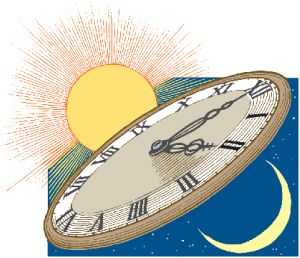
|
| Daylight Saving Time |
Ben Franklin's father was a candle maker working out of his home. Little Benjamin was thus in a position to watch the rise and fall of candle sales with each passing season; it must have been a central fact of that household's economy. Many years later when he was Ambassador to France, the suggestion of Daylight Savings Time was likely less a demonstration of his ingenuity than a testimony to his powers of observation and reflection.
Now, over two centuries later than that, the point is being raised that what with Nintendo and television and all, daylight time may actually cause more consumption of electrical energy than it saves. It's a striking thought, even quite a revolutionary one. Until you remember that Franklin, more than any one person, also discovered electricity.
Philosophy Means Science in Philadelphia
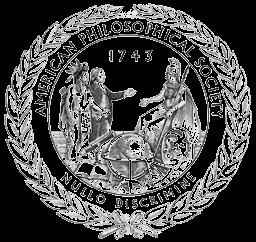
|
| American Philosophical Society Seal |
In the age of the Enlightenment, science was called natural philosophy; that accounts for the present custom of awarding PhD. degrees in chemistry and botany. The sort of thing which interested Ralph Waldo Emerson was called moral philosophy, and you will have to visit some other place than the A.P.S. if that is what interests you. Roy E. Goodman is presently the Curator of Printed Material (some would say he was chief librarian) at the American Philosophical Society, founded in 1743 by Benjamin Franklin who was clearly the most eminent scientist of his day, having discovered and explained the nature of electricity.
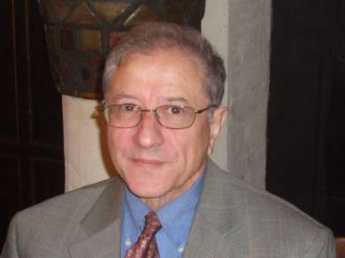
|
| Roy E. Goodman |
Roy Goodman is descended from cowboys and rodeo stars, but in spite of that he gave an entertaining talk recently at the Right Angle Club about this society devoted to useful knowledge, this oldest publishing house and scholarly society in America, once the home of the U.S. Patent Office, and scientific library and museum. They have many rare items in their collection, but the unifying theme is not a rarity, but curiosity. You might say some of the items reflect the whimsy of Franklin, but it would be fairer to say it is an enduring monument to Franklin's universal curiosity about all things.
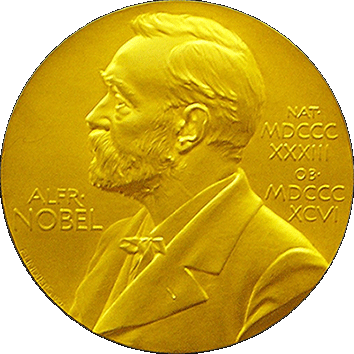
|
| Nobel Prize Medal |
There are about 900 members of APS, about 800 of them Americans, about 100 of them winners of a Nobel Prize. Let's just make a little list of a very few notables in the past and present membership. Start with the first four Presidents of the United States, add Alexander Hamilton and Lafayette, David Rittenhouse and Francis Hopkinson and you get the idea that Founding Fathers got in early. Robert Fulton, Lewis and Clark, Alexander Humboldt, John Marshall were early members, and more recent ones were Madame Curie,
Vanishing Honey Bees
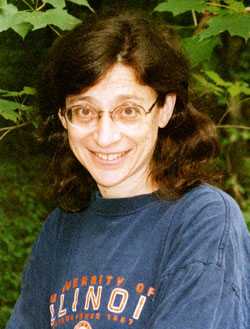
|
| Professor May Berenbaum |
At the Wagner Free Institute, Professor May Berenbaum of the University of Illinois described a mystery disaster which suddenly cut the honey bee population in half during 2008. The nation's bee experts convened at emergency meetings and shared available information to try to figure out what happened. While the matter is not entirely clear, it appears that whole colonies of bees declined because the forager type of worker bee selectively disappeared. No bodies were found in the hives, and the other components of bee colonies were apparently unaffected. Foraging is a stage in the life history of worker bees which precedes their becoming honey and honeycomb workers within the hive, so a disaster for younger worker bees rapidly diminishes the older population of hive workers. Worker bees are sterile females; the fertile queens and drones are apparently unaffected. Speculation as to what has happened to American worker bees has centered on some new pesticides (neonicotinoids) and an Israeli parasite, both of which were new to the scene in the past couple of years.

|
| Honey Bee's |
Most people have little appreciation of the seriousness of this sudden problem. The price of honey can of course be expected to soar, but honey production is now only a small part of the modern bee industry. Three quarters of the revenue of beekeepers is derived from artificial pollination of flowering food plants, usually by trucking hundreds of hives from one region to another, as various food plants come into blossom. In turn, many crops are highly dependent on these bees to supplement wind pollination. The almond crop, the avacado crop, and sesame seeds are all highly dependent on honey bee pollination. The economic effects of a permanent decline in honey bees could have a serious economic effect.
Professor Berenbaum is a Philadelphia girl, having been born in Levittown and educated in the region. She's a charming lady, starting off the lecture by commenting on the old birds and bees tradition. In her view, American children already know more about human sexual behavior than they know about bees.
As a side note, the "Father of Modern Beekeeping" was theReverend Lorenzo Langstroth, also born in Philadelphia. While continuing his active ministry, Langstroth learned that bees would react with comb formation to crevices in the hive according to the width of the crevice. From this, he developed the now-standard rectangular hive with movable partitions, confining the queen bee to the bottom section by laying a screen above it with openings large enough to permit the worker bees to move through, but too small for the queen. Since the moveable partitions could be removed without shaking the whole hive and agitating the bees, beekeeping without hive destruction became practical. An additional feature was that the upper sections contained honey without bee larvae, and could be removed as filled, without reducing the population of bees in the hive. Langstroth's introduction of smoke blown into the hive had the effect of quieting the insects still further. Langstroth in 1848 published an instruction manual for beekeeping which is still in wide use because there was thereafter very little room for further beekeeping innovation. For many decades, honey became the main sweetener in American households. Unfortunately, the present mysterious loss of worker bees has pushed the price of a small jar to more than $40, steadily rising. One hopes the cause and cure of this malady will soon be found.
In the spirit of helpfulness, the following suggestions are offered: disappearance of bees without dead bodies could be explained by insecticide toxicity somewhat better than by disease, because many diseased bees could be expected to find their way back to the hive, while poisoned ones could be killed quickly at some distance from the hive and never make it back. And one further thought is that failure of the bees to be born would explain vanished bees without corpses just as well as distant insecticides would. And the decline of feral bee populations starting in 1945 brings up a possible association with atom bomb tests, just as was seen in the sudden change in the world-wide pattern of human thyroid cancers. Just a suggestion.
Franklin Institute: Hawks and Galileo
Galileo's own little telescope, along with many beautiful and historic instruments of the time are owned by the Medici family in Florence. Their collection of paintings are in the Uffizi, but you have to go to Italy to see them. However, the instrument museum is undergoing repairs, and the Franklin Institute jumped at the chance to put the materials on display while the Medici's weren't using them. The exhibit is large and splendid, including a great many astronomical and surveying instruments which were copied from the Arabs but with exquisite Florentine workmanship. You aren't allowed to look through Galileo's telescope, but a copy is provided, focused on the nine moons of Jupiter. Galileo was angling for a patronage job, so he named the first four moons after individual Medici nobles, a process not too different from what can now be noticed on K Street in Washington, any day. The museum arranged telephone number for cell phones so you can walk around with a guided tour in your hand; pretty neat. Those who have seen the recent play called Galileo will know that the old gent really didn't invent the telescope, and the Dutch are pretty sour about him because they did. But he improved it quite a bit, making his famous astronomical discoveries possible, getting him into trouble with the Jesuits, and forcing his pal the Pope to put him under house arrest even though the Pope surely knew Galileo was right. The earth goes around the sun, not the sun around the earth, but Galileo was pretty snotty about it and probably deserved some sort of rebuke.
The Franklin Institute doesn't make a point of it, but the scientific method was discovered around that time, and around that neighborhood. It's unclear whether Galileo invented the scientific method or not, but no one else claims the credit so it's a possibility. Anyone who has taken a course in Physics knows that Galileo went to the leaning tower of Pisa and proved that nickel would drop just as fast as an anvil, and made many other fundamental discoveries beyond any serious challenge. The scientific method would be a much more fundamental discovery that the sun/earth issue, which belongs to Copernicus in any event. But Galileo's habit of overclaiming in the telescope invention sort of clinches everybody's determination not to give him credit for Science, unless serious proof is forthcoming, and maybe not even then.
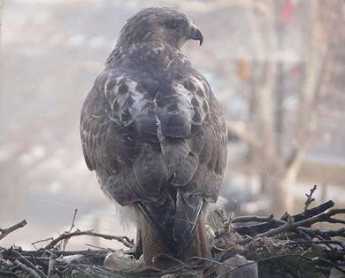
|
| Hawk |
While you are at the F. I. looking at this exhibit, it might be possible to look at the brace of red-tailed hawks who decided to build a nest on the window sill of the board room and bring up a family of real Philadelphia hawks. The young ones are bigger than you would guess, and fuzzy all over. The museum put up a monitor and displays the nest on the Internet. We patched it into this page, to save you the trouble. Hurry up, though. Galileo will be there for three months, but the hawk chicks will probably fly away in a few weeks.
Click here to see the Hawks Live
B. Franklin, Scientist
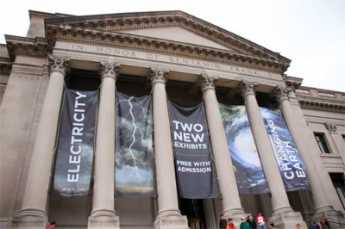
|
| Franklin Institute |
FROM time to time, the Franklin Institute has a display of its own and other museums' collections of the scientific instruments of Benjamin Franklin. It's well worth anybody's visit when it is available because the beauty and craftsmanship of these instruments alone make them remarkable works of art. Franklin was financially able to retire at the age of 42, and it tells you something of the 18th-century culture that Franklin took up scientific experiments in order to be like other independently wealthy gentlemen. Science, or natural philosophy, this seems to have been in a class with getting a coat of arms and having his portrait painted, all of which cheapens our view of Franklin as a scientist.
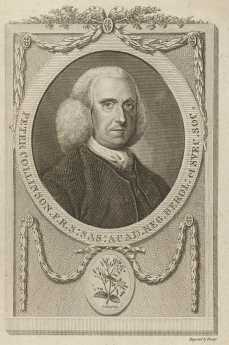
|
| Peter Collinson, F.R.S. |
In fact, Franklin was conducting an active correspondence with other scientists interested in electricity for many years, in particular, one Peter Collinson, F.R.S. in London. Collinson collected thirteen of Franklin's letters about his experiments, the earliest dated 1747, and printed them in 1751 as an 86-page book called Experiments and Observations about Electricity . By 1769, several more letters expanded the book to 150 pages, almost all of them describing reproducible experiments in great detail. The kite and key episode are described, but soberly and sparingly. Without making the point too graphically, an appendix was added describing how lightning had been used to kill some turkeys, so a somewhat increased power would probably be enough to kill a person. Franklin recognized that something was moving from here to there, that it had positive and negative charges, and that it was possible to store it up in a storage battery. He recognized the difference between substances that would conduct electricity and other substances that would act as insulators. Later on, he would discover that the torpedo fish stores and transmits electricity, suggesting that somehow animals made and used electricity as part of life. And of course, he put the discoveries to practical use as lightning rods, which he refused to patent.
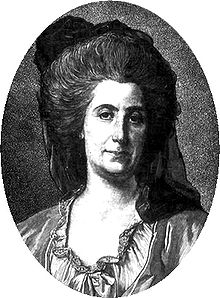
|
| Madame Helvetius |
By the time he went to England and France as a negotiator, his wide acquaintanceship in the scientific world was happy to introduce him to other famous people, like kings, Voltaire, Mozart, and Madame Helvetius the wife of the Swiss philosopher, the only woman to whom he is known to have made a proposal of marriage. When someone mentioned standing before a king, he replied he had stood before five of them. King Louis XVI, for example, appointed Franklin to a four-man committee to investigate hypnotism, then being touted as "animal magnetism" by Franz Mesmer. The other three committee members were unfortunately also destined to become acquainted with the guillotine: Brother Joseph-Ignace Guillotin himself, and two future victims of the invention, Antoine Lavoisier the discoverer of oxygen, and Jean Sylvain Bailly who first calculated the course of Halley's Comet, not to mention Louis XVI himself. It is not easy to think of any other scientist who was able to mix his scientific fame with changing international history, acquiring in the process the sobriquet of the founder of the American diplomatic corps. But then, he was witty as well as smart, and his career is a warning to those who now hope to devote their whole lives to being admitted to a prestige college and then coasting on its reputation. Franklin, it should be remembered, dropped out of school after the second grade.
Barringer Crater in Winslow AZ
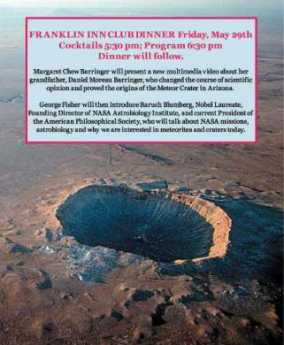
|
| Barringer Crater |
There are several big holes in the ground, clustered fairly close together in the high plains of northern Arizona. One of them is an extinct volcano, one is a sink-hole where the ground collapsed over an empty aquifer, one is the Grand Canyon. And one of them is the Barringer meteorite crater, about a mile wide and half a mile deep. In the summer, environmental temperatures above 105 degrees are fairly common, and as I have reason to know, the crater can be covered with two feet of snow in February. It's near the town of Winslow, and was called the Winslow crater in a popular song, Take it Easy by The Eagles of ten or more years ago, as well as being featured for the last fifteen minutes of a movie called Starman that is still reasonably exciting to watch.
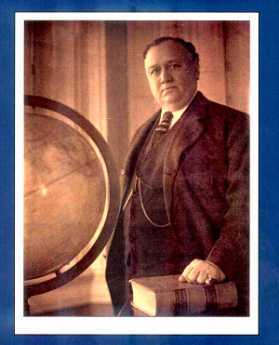
|
| Daniel Moreau Barringer (1860-1929) |
As recently explained by Margot Barringer at a dinner at the Franklin Inn Club last week, the crater was explored, and purchased, by her grandfather, Daniel Moreau Barringer (1860-1929), who had made a fortune in mining discoveries and could afford to buy a big hole in the ground. Daniel Barringer was a Princeton classmate and friend of Woodrow Wilson and Cyrus McCormick, as well as a friend of Theodore Roosevelt. Barringer's young son owned a .22 rifle and amused himself shooting at mud puddles. One day, he exclaimed that the shapes of the bullet holes in the ground were exactly like the shape of the Arizona hole; they all had a circular opening no matter what direction the bullet came from. From that came the idea that the crater was not an extinct volcano as many local natives believed, but the crater of a meteor, since the mouth of the crater would remain roughly circular regardless of the direction of the impact. That shape helps explain the confusion with the mouth of a volcano. While generally accepted today, meteor craters were a comparatively recent idea at that time. Geologists like to argue a lot -- Barringer himself was particularly vocal-- and it took quite a few years before the meteor theory of this particular crater was generally accepted. Poor Barringer became obsessed with the idea that commercial deposits of iron ore could be found if you dug deeply in or around the crater, but it wasn't true, and he essentially lost his fortune trying to dig 28 deep holes there. Sadly, he died of a heart attack very shortly after the scientific world finally agreed with his Theory of the crater's formation. The decline in the family fortune may also have been related to the significant year -- 1929 -- of his death. Two other granddaughters have written an interesting book about this personal and geological struggle.

|
| Baruch Blumberg |
At the Franklin Inn dinner, Baruch Blumberg (who had won a Nobel Prize for the discovery of the hepatitis B virus and its vaccine) then offered a fascinating discussion of meteors and craters. He's President of theAmerican Philosophical Society, but his credentials for this topic come from his second career as Director of the Astrobiology Institute of NASA. He tells us it might be better to call it an asteroid crater since most meteors are circulating asteroids that lose their way and come crashing through our atmosphere. There are quite a few asteroids floating around reasonably close nearby, and more big ones can be expected to drop in on us about once every two thousand years in the future. NASA seems to have given a lot of thought to this topic, including a theory that the moon was once a piece of the earth which got knocked loose by a big asteroid hitting us at some distant time in the past. There's a big crater in Siberia, and it is thought that dinosaurs were exterminated by a huge asteroid hitting the Yucatan. When you look at the surface of the moon, you see that lots and lots of asteroids have been flying about, but most of the evidence has been eroded away.
If there is a serious danger of another big one hitting us, and smart people can calculate its future path, what can we do about it? Well, the people at NASA have given that some serious thought. Attaching an outboard motor to the asteroid doesn't sound very workable, but painting one side of it white might be because white will reflect light and heat and push the asteroid in some different direction. And shooting big bombs at it to change its course might be practical. Right now, all of the asteroids seem to be headed in harmless directions, but it pays to be prepared.
The idea that iron and nickel could be found in the crater comes from knowing, Lord knows how that the center of the earth is molten iron. That creates the theory that asteroids might be mostly made of iron, burying commercial amounts of it underground when they hit. Unfortunately, the size calculations are all wrong, and Barringer's son had it about right that a .22 bullet would kick up a much larger hole than itself. Anyway, some consolation lies in 250,000 paying visitors to the crater every year, and an occasional movie or NASA experiment paying for temporary use. The downside of economics is that Barringer had eight children, and lots of them had lots of children. Fecundity seems to be a characteristic of most Barringers; one member of the clan estimated at least a thousand living relatives at one remove or another, all of them presumably willing to share in the gate receipts if some learned counsel advises an aggressive approach.
So, since it more or less belongs to Philadelphia, more visits to this crater are recommended. Except, perhaps, in February. April, when the desert is in bloom, might be more enjoyable.
REFERENCES
| A Grand Obsession: Daniel Moreau Barringer and His Crater: Nancy Southgate: ASIN: B0006SAYHU | Amazon |
Geckos: Academy of Natural Sciences brings Mini Dinosaurs

|
| Gecko |
FRIENDS who spent time in Vietnam have a lasting memory of lizards stuck to the ceiling, catching flies with their tongues. Those animals are named geckos, one of the oldest and probably most varied families of reptiles, but confined to the Southern hemisphere. Fossils have been found containing geckos from fifty million years ago, so they were here before the big dinosaurs were wiped out, when the Yucatan was probably struck by an asteroid.
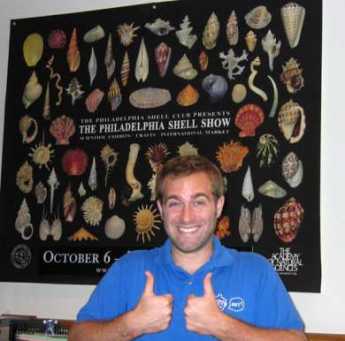
|
| Anthony Geneva |
There was a time when Africa, India, South America and Antarctica were united in one monstrously big continent, and the many varieties of gecko are scattered over the land masses which originally made that up. At least this is the way Anthony Geneva explains it to visitors to the Academy of Natural Sciences at 19th and Ben Franklin Parkway. There are no geckos to be found naturally in Philadelphia. Philadelphians hardly need reminding that the first dinosaur bones, ever, were discovered in Haddonfield NJ, and were soon taken to the Academy for permanent display. Ever since that time, the Academy's collection of dinosaurs has expanded, and are the things with the most impact on school-age visitors. The Academy is getting ready to celebrate its 200th anniversary in a few years, however, and contains much more than dinosaur bones, including extensive research facilities with world-famous scientists at work in them. In any event, the dinosaur image is a clear metaphor for the present display of little reptiles that look like dinosaurs, whatever the DNA trail may be. The main exhibition area is currently filled with dozens of glass display cases containing live geckos, and the little rascals are so good at camouflage that you have to hunt carefully for them before they suddenly seem to emerge from the shadows. There are white ones, black ones, bright green and bright orange ones, speckled in all sorts of weird patterns. They make sounds resembling bird songs, and the term gecko is a native word referring to such sounds. The Academy displays these gecko-noises for visitors who are invited to push twenty or so buttons. Geckos move, but suddenly, and probably for some predatory purpose. If you are really into geckos, you focus on their feet.

|
| Gecko |
The variety of toe and foot shape is almost infinite and seems more so if you have a magnifying lens. The foot pads terminate in different kinds of extremely fine hairs, and that's their big secret. Those hairs are so fine the molecules of the foot and the molecules of the wall or ceiling attract each other magnetically. Since no energy is expended in the adherence, the gecko can remain attached to a wall or ceiling indefinitely, even after the gecko dies. But, by raising the angle of contact to thirty degrees, the foot detaches, and the little rascals can scoot along very rapidly, upside down. At present, there is a great deal of commercial and maybe military interest in clarifying the secrets of this adhesion. To be industrially useful, the footpad size would have to scale up to much larger dimensions, but just imagine gluing together the vessel ruptures and aneurysms inside the brain as we now do in a cumbersome manner with chicken-wire stents, just one example that quickly occurs to a visitor. If these little fellows figured out how to make these reversible adhesives fifty million years ago, our scientists ought to be able to imitate them.
Drop around to visit the Academy. It's filled with amazing things like this.
The University City
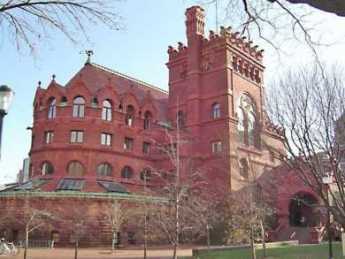
|
| University of Pennsylvania |
In 1920, the University of Pennsylvania graduated 34 students with B.A. degrees, and 134 with M.D. degrees. Today, the campus is a little self-contained city of 50,000 inhabitants. The transformation of the campus during that period is an outward expression of revolutionary expansion of the student body, involving demolitions, restorations, new construction. And the nearly constant shortage of parking space.
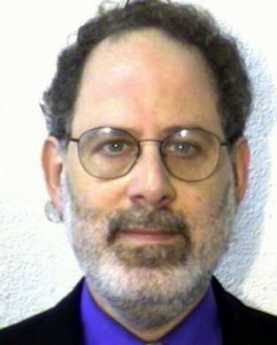
|
| David Hollenberg |
David Hollenberg, the University Architect, recently gave the Franklin Inn Club an interesting description of the University from the point of view of bricks and mortar. Since almost every building on the campus is undergoing or plans to undergo a major building project, he had a lot of material to cover. The disappearance of the railroad-based industrial area of West Philadelphia has been an economic problem for the city, but of course, this abundance of vacant land has created a major opportunity for the University of Pennsylvania. One reflection of this abundance is the opportunity to become the developer for much of the whole region around the campus, working with private developers who wish to be in the University area, and are therefore willing to coordinate their plans with those of the University. It's a remarkable opportunity. Since it comes at the time of a major economic downturn, one can only hope that the University does not impoverish itself taking advantage of this good luck.
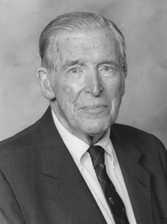
|
| Jonathan E. Rhoads |
As the graduation statistics illustrate, not so long ago the University was largely a medical school, with appendages. There are rumors of considerable friction from time to time, between the President of the University and the Dean of the Medical School as to who was boss; it is easy to imagine the trustees swinging from one side to the other. The most notable Provost of the University in modern times was Jonathan Rhoads, who also happened to be Professor of Surgery. If you know Quakers, you know that disputes were seldom rancorous. And if you know Jonathan, you know he almost always won the disputes.
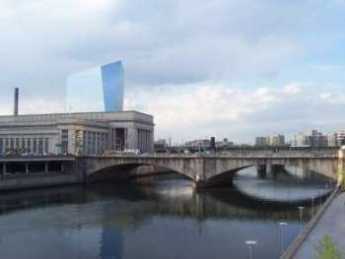
|
| Cira Center |
While today, the dominant change is caused by the Cira Center buildings and the acquisition of the former Post Office building, it is well to keep in mind that the new Cancer Center is a billion-dollar project. A great deal of the medical school expansion is centered on burgeoning research, particularly in molecular biology, largely financed by the National Institutes of Health. While the leaders of the NIH have long struggled with Congress to keep politics out of both the administration and the substance of research, it seems to old-timers that the politicians are slowly winning. Senator Specter's seniority on the Appropriations Committee may have had as much to do with the prosperity of West Philadelphia, as the quality of research, however eminent. We are about to find out, and if things go hard with us in favor of say Chicago, it could be a wrenching experience. Most of those research buildings cost more to heat, air-condition, insure and clean than the entire tuition base of the students; and they wouldn't be good for much if you tried to sell them.
The University is almost unique in being located on contiguous land, near existing public transportation, and occupying substantial old structures capable of renovation to new purposes. Mr. Hollenberg was asked whether it was cheaper to grow like this within a city, or whether it is cheaper to plant a totally new university in several open corn fields, as we often see happen. While this is a hard question to answer, and depends to some extent on the type of architect in charge, it is his view that big-city restoration is a considerably cheaper way to expand than building from scratch on open land, although if you are starting the institution itself from scratch, there isn't much choice but the cornfield.
And then, there is the ancient argument between academics and bricks and mortar. Development officers agree that it is easier to raise donations when you can name a building for the donor; grand visions for new frontiers of teaching are a much harder sell. So a question does hang over this expansion, however exciting, whether the endowment will keep up with the structures, once the excitement of physical expansion dies down. These are definitely things to worry about, but right now you seize the opportunities as they go past, leaving integration to your successors to figure out.
------------------------------------------------------------------------------------------------------------------------Pyramid-Building, Greatly Simplified
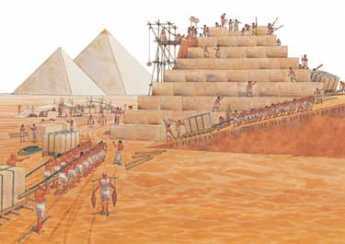
|
| Egyptian pyramids were supposed to be built |
Everyone who went to Sunday School knows the Egyptian pyramids were supposed to be built by huge numbers of slaves, quarrying stone blocks, transporting them with only crude rollers, and setting them precisely in place under the supervision of slave-drivers with whips. The number of stones has been estimated, a reasonable time estimate made for carving a block, and modern scholars have calculated that every single person in Eqypt must have been either a slave or a slave-driver. In fact, there is a theory among British scholars that such a mobilization of the entire nation could only have been motivated by religious fanaticism, since it's so hard to imagine keeping a nation at work involuntarily in the hot sun for twenty or more years, even with whips.
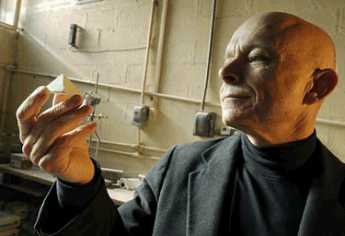
|
| Michael Barsoum |
As recently described to the Right Angle Club by Professor Michael Barsoum of the Ceramics Department of Drexel University, we probably have to revise our views. A "Eureka" moment seems to have first arrived for a French Professor named Joseph Davidovits several years ago, with the thought that perhaps the building blocks of the pyramids may have been cast in place rather than carved. Poured concrete, so to speak, rather than carved out of a quarry and pushed over the desert in some fashion and hauled up into place. Since the blocks seem precisely chiseled to fit together exactly, it has always been hard to imagine how this was done, when the Egyptians were thought to have no iron tools, only pure copper as a metal ingredient, not even bronze.
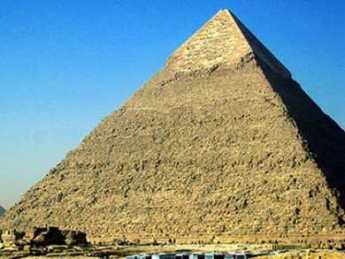
|
| Khufu Pyramid |
The insight was brilliant, although the evidence for it was weak, and it has been pretty easy to pick holes in the proposal. Poured concrete is much easier to reconcile with the remarkable leveling of the stone blocks, where the bottom level of the Khufu pyramid is the size of eight football fields but only varies from true level by one inch overall. Exploratory cuts into the sides of the pyramids reveal the component stones to vary enormously in size and shape in the interior, although the exterior surface is quite smooth. Similarly, the lateral sides of the pyramids vary from true north by only 1/15 of a degree, a remarkable achievement for stone cutting with primitive tools. Broad Street in Philadelphia supposedly runs North and South, for example, but it deviates from true north by six degrees. The pyramid builders, like the architects of ancient Beijing, must have used the Pole Star for orientation, rather than a magnetic compass.
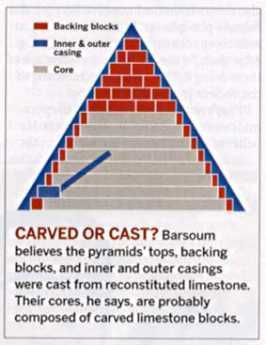
|
| Carved or Cast |
While Davidovits got this line of thinking started, Michael Barsoum has considerably advanced the proof of idea by addressing a large number of nitty-gritty questions about just how all this might have been accomplished. For example, the science of ceramics shifted the idea from the Portland Cement model to a recognition that the calcium in the cement came probably from diatomaceous earth, which is to say the crushed skeletons of diatoms on the ocean floor. Microscopic examination of the cement reveals large numbers of intact diatoms, with the cement layer surrounding the limestone aggregates. Furthermore, analysis of the stones shows that the outer shell of the pyramid was cast concrete, but the interior main mass was composed of stone rubble of various sizes and shapes. The apex of the pyramid was pure casting, probably because of the difficulty of fitting exterior and interior stones at the point. So, the Drexel team carried Davidiovits' idea from a general concept to a practical description of how the construction was probably accomplished. Carbon dating was attempted, but this technique stops being accurate for such remote time periods.
To nail down the idea that Philadelphia really explained how to build pyramids, funds are being collected for the construction of a 27-foot model pyramid in Logan Square. Let's hope the community gets behind this effort, which is both scholarly and entertaining, with an element of international competition mixed in. After all, Philadelphia is still smarting from the erection of the Eiffel Tower, six feet higher than Philadelphia City Hall, as the tallest structure in the world at that time. Let's be clear about it: the Eiffel Tower was the tallest structure in the world, while our City Hall remained the tallest building.
What's Different About Kosher ?

|
| Kosher Foods |
About half of the labeled food products in a typical supermarket are designated Kosher, displaying a "K". That seems remarkable when only about 1 million American Jews are observant or Orthodox, thus eating only Kosher food for religious reasons. So, the Chemical Heritage Foundation recently decided it would be interesting to examine the definition and details of the Kosher designation, which presumably has some chemical basis. The CHF was right about the interest in the topic; attendance at the auditorium was packed. The following is entirely derived from what was discussed there.

|
| Rabbi |
One might have carelessly supposed that a religious designation of food products would have an exclusively religious basis, probably related to preparing the product according to a religiously defined method or ceremony. That's essentially true, but what is unexpected is that the choice of food to be included or excluded must obey a strict and extensive set of rules. The basis for the rules is found in the Old Testament, but specifics have been evolved by designated Rabbis, rather like the way the interpretation of the U. S. Constitution is left to the U.S. Supreme Court, and has considerably evolved in the process. An examination of these evolved rules is what leads other denominations of Jews to avoid the issue or even to decline to endorse it. That makes it rather awkward for chemists to understand the Kosher process in strictly chemical terms. For a perhaps extreme example, hard cheese but not soft cheese is strictly forbidden within Kosher rules. That's because the rules state that eating meat is fine, eating cheese is fine, but six hours must elapse between eating either one. What's forbidden, then, is a mixture of meat and dairy. Hard cheese is produced by exposing soft cheese to rennin, or rennet. Rennin is produced from the stomach of cows, so the interaction is deemed to be simultaneous rather than separated by more than six hours. It certainly is true that a chemical reaction between two ingredients is difficult to imagine if it is anything but a simultaneous contact between the two. So, chemists would have to agree that hard cheese involves less than a six-hour separation between meat and dairy. But most chemists would regard this interpretation to be somewhat strained; to punish people for disregarding it seems excessive. Whatever disagreement there may be is not based on the facts, but on the importance to be attached to them.
Similarly, most chemists would resist the idea that a chemical product derived from two different sources differs in any way at all. The most important example of this issue is glycerine, a common food additive. A fat consists of three fatty acids attached to glycerin; pure glycerin is produced by separating the fatty acids from it, and in any event, the fatty acids of pigs and cows are also chemically identical, at least in the view of chemists. Glycerin derived from pig fat thus seems to chemists to differ in no meaningful way at all from glycerine derived from cow fat. To those in charge of Kosher rule making, however, the difference in the source is vital, needing to be searched out in minute detail. Since Coca-Cola contains traces of glycerin, and the Coca-Cola manufacturer wished to have a Kosher label, the company somehow had to satisfy the Rabbinical demand that the sources and processing steps of the glycerin be identified in minute detail. Coca-Cola contains a secret ingredient which some believe is essential for the true Coke taste; the company was not going to reveal its processes. Somehow, this quarrel was resolved privately, although it is not easy for outsiders to imagine how it could be.
And so on. There may, of course, exist many Kosher rules which make perfect sense; the speakers did not go into that. What remains of general interest is the question why so many non-Orthodox Jews, in fact so many people who are not Jewish in any sense, insist on eating only food with a Kosher label. At the conference, it was explained that many people who have been told they are lactose-intolerant, or allergic to some protein, become fanatic in their fear of contact with such chemicals. That is, as a matter of fact, a common observation in many doctors' offices. These people seem to have developed the idea that they can trust the Orthodox rabbis to be even more fanatic than they are if anything more rigid and unyielding in their pursuit of particular exclusions. While that has driven many Jews away from Orthodoxy into other religious directions, it has served to reassure the health fanatics. The food manufacturers don't particularly care about the social features; if that "K" sells the product, they want to have it.
On hearing of these issues, one of my Jewish friends suggested an extension to Jewish kitchens. It was his view that if a real estate agent shows you a house with two or more ovens, two or more stoves, or even two or more kitchens, it probably had a Jewish owner at some time in the past. Multiple kitchen arrangements are much less likely to reflect an owner who likes to entertain a lot, than an owner who has been told of the six-hour mandatory wait between eating both meat and dairy, and has persuaded himself this rule extends to the separation of stoves. There's no great harm in any of these beliefs, of course, unless it is somehow represented that they improve the health of the believer, which would drag a highly reluctant Food and Drug Commissioner into a dispute he can't win, no matter how he rules.
Whatever the complete truth of all these suppositions, they lead the casual reader to let his thoughts meander. There's a similarity here to a great many other prohibitions and adherence, tenaciously adhered to, resulting in elections won and lost, provoking scorn heaped on non-believers. And even to totally unrelated legislation getting derailed because legislative representatives were unwise enough to take a stand on this one. Pro or con.
Philadelphia Chromosome
Every Spring for the last 185 years, the Franklin Institute has honored the most distinguished scientists alive; Franklin would certainly be proud of the Institute named after him. In recent years, many awards were combined into two categories, the Bower Awards and the Benjamin Franklin gold medals. Unlike the Nobel Prize, the Franklin Institute Medals are not given for eminence in a designated field of science, but rather are given out by a hard-working committee of scientists who ask themselves What are the really hottest scientific fields at present, and then ask panels of international referees Who is most eminent in that field? The awards thus effectively avoid fields that are temporarily stale and static, by being unrestricted in advance to particular fields. The approach of searching for the greatest minds rather than greatest achievement may well lead to the same award, but the method of choice seems more harmonious with the spirit of Benjamin Franklin, who not only excelled in the field of electricity but actually invented that whole field. The subtle shift in emphasis seems to have been well received; this year's Awards Banquet was over-subscribed before the invitations were printed, and a capacity audience of 800 attended a superb reception, dinner and audio-visualized live ceremony. Actually, the ceremony extends for a whole week, with scientific symposia and in-person meetings with high school students designed to interest them in science.
This year eleven scientists, the most prominent of whom were Bill Gates and Peter Nowell, received the medals. We'll get to Bill Gates in a while; for the present, let's concentrate on Peter Nowell, who invented the Philadelphia Chromosome. What's that?
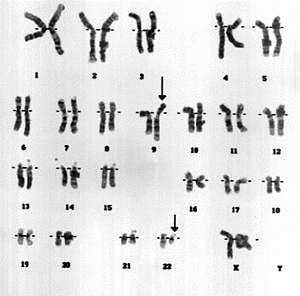
|
| The Philadelphia Chromosome |
Well, from 1921 to 1955, it was generally held that people, members of the human race, contained 48 chromosomes in every cell in their bodies. The chromosomes were thought to contain the genetic code governing our biological construction, explaining the difference between us and fruit flies, which for example only have four chromosomes per cell. After painstakingly examining the appearance of the chromosomes in different people and in cancer cells, it was then generally held that cancers never seemed to have any genetic abnormality. After all, the chromosomes of cancer cells looked exactly like those in normal tissue: Forty-eight chromosomes, never differing in cancers, so go look somewhere else for the cause of cancer. Unfortunately, the state of scientific development fifty years ago can be summarized by noting that about that time it then became established we really only had 46 chromosomes, not 48. As for cancer, the M.D. pathologist Peter Nowell, then noticed in 1956 that a patient with chronic myelogenous leukemia had an extra translocation on one particular chromosome, giving it a funny shape. This translocation was furthermore present in every single other leukemic cell suggesting that one cell had somehow undergone a single mutant change, and all the rest were its descendants. At least in CML (chronic myelogenous leukemia), it suddenly looked as though the cause had been found since the further study revealed the same was true of just about everyone who had CML. At first, it was felt that while maybe the cause of this particular type of cancer had been found, every other cancer might still be caused by something else. Not so. From believing no cancers were genetic in origin, Peter Nowell started us on the path of now being confident all cancers have a genetic cause.
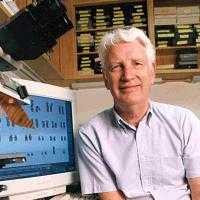
|
| Dr. Peter Nowell |
How could we all have been so wrong; can't scientists even count up to 46? No, as a matter of fact, in 1955 it was pretty hard. If we couldn't even tell how many of them were there, it's obvious the comment they all looked alike wasn't worth very much. As Peter shyly admits, his discovery was a result of being trained as a physician rather than as a life scientist; he knew what leukemia looked like, but at that time he didn't know very much about chromosomes. It happens chromosomes spend most of their lives expanded into tiny filaments too small to examine under the microscope. But as they enter the stage of cell division called metaphase, those filaments shorten and thicken up, becoming a lot easier to examine. As a pathologist, Peter didn't bother to stain his slides in dilute salt solution, but just washed them in tap water. The tap water had caused the cells to swell up and burst; those that happened to be in metaphase dumped their stubby chromosomes out where they could be stained and looked at. Simple. Doesn't everyone wash slides in tap water?
So fifty years ago, the general question of what causes cancer finally narrowed down to the right sort of specific question. Thousands of scientists, spending billions of dollars from the National Institutes of Health, sharpened the focus of their search considerably. It certainly looks as though someone is going to carry the search the final step, pretty soon. However, the fact that fifty years of intensive study still hasn't quite found the answer is an illustration of how fiendishly difficult the search really is. Each year that might have been spent futilely avoiding genetic searches would have added one year more before the answer was finally found. By the way, why is it called the Philadelphia Chromosome? In 1955 it had been decided by the scientific community that every genetic abnormality would be named after the city in which it was discovered. Dr. Peter C. Nowell of the University of Pennsylvania and the late Dr. David Hungerford of the Fox Chase Cancer Center were the joint discoverers, so obviously it was entirely a Philadelphia discovery; at that time it had been made a custom that genetic abnormalities were named after the city where they had been first found.
It would be a mistake to conclude that nothing new has been discovered in half a century of research. It has been established that not only Myelocytic Leukemia but essentially every cancer starts with some genetic abnormality, which triggers the expression of "mini RNA". These abnormalities then apparently express a cancer-producing action by triggering an abnormal factor in the cell signaling system, called tyrosine kinase. Drugs with the effect of paralyzing that enzyme have been found to be curative in 95% of cases of chronic myelogenous leukemia, and some other forms of lymphoma. We're certainly getting closer, step by unexpected step, to the answer. In fact, we may be getting even closer to a point where drug research can jump to seeking cures without precisely defining how the cancer was caused. After all, if cancer is caused by a chain of cellular events, it may not matter where you break the chain. That realization appeared with, first aspirin and then the statin drugs, for treating heart attacks and strokes, even though we are still not completely clear about how atherosclerosis is produced. Meanwhile, the death rate from hardened arteries has dropped by half.
It wouldn't be right to omit mention of Peter Nowell's Quaker heritage. Although he isn't a Quaker, his mother was a Matlack, a direct descendant of Timothy Matlack, the Haddonfield Quaker who was the scribe for the first writing of the Declaration of Independence. Sitting in silent Quaker meeting, polishing and simplifying one's message before delivering it, is very good training for a habit of simple, direct thought. As Dr. Nowell phrases it, he is a chronic "lumper" of ideas, when so many scientists are content to be "splitters". Splitting complexity into its essential components is a useful approach. But somewhere, someone has to get to the heart of the matter.
Lumpers In Constant Combat With Splitters
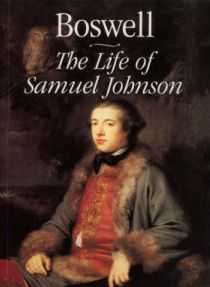
|
| James Boswell's Book |
Some colleges produce managers by teaching management theory, but in certain Ivy League colleges it is thought to be more useful to teach how to dominate a committee, eventually perhaps a board of directors, or a board of trustees. The handbook of instruction is James Boswell's Life of Johnson which is a rather large book of verbatim notes that Boswell took of his many lunches at a London club in the 18th Century. Boswell was a quiet mouse privileged to sit in the company of the great Dr. Samuel Johnson, surrounded by the most eminent intellects of the Enlightenment. Boswell carefully manages the background of each episode, describing the issue and the various arguments, and then -- Sam Johnson's booming voice settles the matter. After he speaks, the meeting is over.
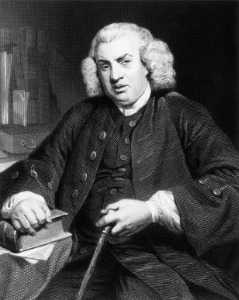
|
| Dr. Samuel Johnson |
"Why, sir", says Johnson, and then look out for the one-liner to follow. We get the impression that Dr. Johnson used that "Sir" signal to indicate he had enough of these dumb arguments, and soon would come the growled epigram that scatters any token resistance. Boswell may have neglected to record instances where the great Johnson was defeated in debate, who knows. We are left with the distinct impression that if you engaged in lunch table conversation with Sam, you were almost certain to lose. So that's what Ivy League students are being taught: how to win a debate at a committee meeting, in the expectation they would spend much of their lives in committees, boards, and even cabinets. That's how the English-speaking world gets its work done and its decisions made. That's what lunches at the Franklin Inn Club, or the club tables of the Union League, are trying to do for the education of neophytes.
As the goggle-eyed student of the great Chauncey Tinker, who gave young Pottle his start in life, it was an awesome performance for me to watch. But the rules of this game never became entirely clear to me, I'm afraid, until the other evening when I listened to Peter Nowell describe in a half-dozen brief paragraphs how he had revolutionized prevailing theories of the cause of cancer. The Franklin Institute then followed the award ceremony by putting on an all-day symposium of notables who run elaborate enterprises in cancer research, essentially funded by the National Institutes of Health, your tax dollars at work again. Last year, the NIH dispensed thirty billion -- you heard me -- dollars in research grants to internationally known research entrepreneurs, and if you can stay awake during their talks, there must be something the matter with you. So far as I could see, they were painstakingly describing every grain of sand on the beach, whereas Peter Nowell made the whole beach electric and clear in ten minutes. Essentially, he was saying that each patient's cancer is caused by a long chain of events, starting with a single mutation within a single cell. All the other cancer cells of a patient are descendants of that first one, which triggered the cascade of chemical events now repeated by the descendants. To stop the process, you probably only have to find a way to break the chain at one vulnerable point. Then you have a cure, without necessarily understanding every other link in the chain.
Peter Nowell described himself as a "lumper", admitting that most scientists are "splitters". A splitter quite reasonably attacks a complex problem by isolating one small piece of it at a time; that's really a pretty good way to address overwhelming complexity when you encounter it. But you can be sure that people of that mindset should not be found in a President's cabinet, deciding how to save the world from impending disaster. Whether by their own genetic predisposition or as a result of peer pressure in their profession, they are habitual splitters. And it suddenly occurred to me why Sam Johnson's one-liners always won the argument; he was a lumper. Usually right, sometimes wrong, never in doubt. Witty as a Frenchman, but as quick as a rattlesnake. Cordial, perhaps, unless you disagreed with him.
We need more lumpers. If they get that way from the likes of Chauncey Tinker, we need to print more copies of The Life of Johnson. If they are born that way, maybe we need a breeding farm for lumpers, which is what the Assembly Ball amounts to. But don't get me wrong, we need more splitters, too. They just have to learn their place at the table.
Marcellus Shale Gas: Good Thing or Bad?
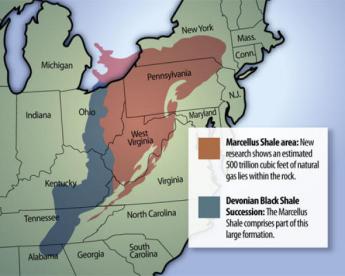
|
| Marcellus Shale |
Soon after discovering widespread hard and soft coal, Pennsylvania found in Bradford County it also had oil. Local oil was particularly "sweet", with a low sulfur content. Long after much cheaper oil (cheaper to extract, that is) was found in Texas and Arabia, Pennsylvania oil was prized for the special purpose of lubricating engines, which commanded a higher price. This discovery of oil in the western part of the state also provided a vital competitive advantage for local railroads. Other east-west railroads like the New York Central and the Baltimore and Ohio lacked a dependable return cargo like this, so the Pennsylvania Railroad lowered prices and became the main line to the west for a century. Refineries were built in Philadelphia, and continue to dominate Atlantic coast gasoline production, even though the source of crude oil is mostly from Africa. When oil and coal declined in use, Pennsylvania's industrial mightiness declined, too. Philadelphia and Pittsburgh lost much of their competitive advantage, while the center of the state just about went to sleep. When even Texas oil later ran low, America's industry turned to computer-improved productivity to keep its prices competitive, helping California at the expense of Pennsylvania. The bleakness for Pennsylvania may not last, however. Suddenly, we discover we have another enormous source of cheap energy, shale gas.
It's rather deep, however, even deeper than our supply of fresh water. The next layer below surface minerals is porous rock filled with fresh water, the so-called aquifer. Gas bearing shale is layered just under the aquifer. We'll return to the aquifer later.
There is and will be abundant oil in the world, well into the future; but cheap oil has been selectively depleted. When military and economically weak nations like the Persian Gulf had cheap oil, only transportation costs were irksome. But now Russia is emerging as an oil-rich state, previously impoverished states like Iran are asserting themselves, the existence of an international oil cartel becomes more threatening because it reinforces oil price with military threats. Raw material discoveries -- gold rushes -- are always destabilizing because they are tempting to the dictator mindset. That's known in the political literature as the source of the "Dutch Disease", not because Netherlanders are aggressive, but because North Sea oil discoveries destabilized the politics of even that little peaceful nation. America has now made a universal decision to establish energy independence. It once was credible to make predictions that in a decade or two, we would run out of competitively priced energy. To be both rich and weak invites aggression and we knew it.
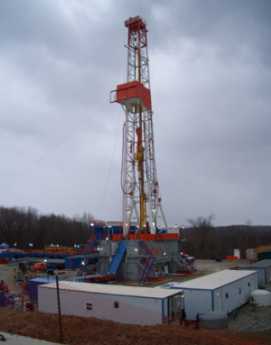
|
| Gas Drilling |
There's little question America is profligate with its energy, so the need for energy conservation is undisputed. Actually, we are already five times more efficient with energy use than China is; furthermore, we have improved energy efficiency by 20% while China has defiantly worsened. We'll do better, but unfortunately, our immense investments in inefficient home heating and transportation are too costly to discard abruptly in both cases. There is also little question that American research and development of alternative energy sources has been neglected, while China is subsidizing R & D appreciably. In our frenzy, converting food into gasoline by subsidy is a bad joke, electric cars are subsidized and widely described as "Welfare buggies", wind power is twice as costly as carbon-sourced energy and needs better battery development to be able to store it, atomic energy has been encouraged by the French government, but totally held back by ours, in response to public anxieties. The long and the short of it is this: we face a fifteen-year period of doubtful energy sources, a vulnerability our international competitors and enemies might easily use against us.
And then along came shale gas, like a gleaming savior on a white horse. For seventy-five years, the world has known unlimited amounts of petrol carbons are locked into vast stores of shale. Unfortunately, it is buried deep, and located where it is expensive to transport to market. The techniques for extracting such carbons were unacceptably expensive in a world that shrugged off abundant oil. Politics and geology turned against us; we now need fifteen years of catch-up to make alternative energy sources more affordable. Cheap oil ran out before non-carbon sources became practical. But miraculously shale gas is now upon us, right here in Pennsylvania. It takes a long time to map out the existence of shale from Canada to Texas, when it is 8000 feet deep; it was first recognized in 1839 from a cliff outcrop around the little town of Marcellus, New York and vigorously explored in the disappointed hope it would lead to discoveries of bituminous coal, iron ore or other minerals. Land speculators have been roaming Pennsylvania for two centuries. Now, they are offering $5000 an acre plus royalties, just for the right to drill. In 2010, probably 5000 leases will be issued. Needless to say, the discovery is popular with local farmers, and "gas fever" has enormous political momentum. With techniques discovered around Fort Worth, Texas, about 10% of the existing gas can be extracted easily, serving America's energy needs for much of the 15 years required to make renewable, non-fossil, energy cheap and practical. This long history paradoxically accounts for the apparent suddenness of the current popularity; it's not a new mineral discovery, it is the development of practical extraction methodology at a critical political and marketing moment.
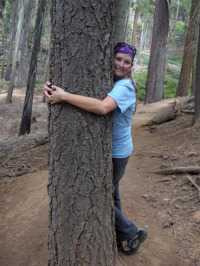
|
| Tree Hugger |
And equally needless to say, the environmental movement is being called to its barricades. Whatever is their objection to drilling for gas, 8000 feet below the surface of a wilderness? In the first place, just cutting roads through the forests is destructive to migrating and local bird populations. In a well-known process of "fragmentation", the cutting of roads allows an invasion of raccoons and similar bird predators. Forest fragmentation simply cannot be avoided if drilling rigs are to enter and leave the forests; some vulnerable bird species are bound to go extinct. This particular region is particularly prone to emissions of radon, which is a radioactive gas traveling along the stone layer and occasionally entering the basement of houses; will drilling through to the shale layer make radon seepage better or worse? Furthermore, since this sedimentary shale layer lies underneath the aquifer, drilling must go through the freshwater-bearing caverns before it gets to the shale; expensive sealing methods may be needed to keep the contaminants below from seeping up through and around the drill holes. The practice of fracturing the shale by high-pressure mixtures raises issues with water, sand, and chemicals. Water consumption is millions of gallons per year per well, seemingly enough to drain the rivers and creeks. Some operators will be tempted to use the aquifer as a surreptitious source of water, leading to consequences hard to anticipate. The sand is meant to support the walls of the rock fractures but may clog up other channels unintentionally. And the composition of the chemical drilling components is a trade secret which the extraction companies naturally wish to keep private; it's pretty hard to get public approval of a secret. So to sum it all up, there is a legitimate need to hurry the drilling, and there are legitimate environmental safety issues to be addressed, slowing it all down. New York State has passed laws prohibiting further drilling. Is that an opportunity for Pennsylvania, or a warning we should heed?

|
| Where's My Aquifer? |
This is a time for serious negotiation, and the spending of serious amounts of money on study and monitoring, not for shouting. Politicians sense you can't make omelets without breaking eggs. For them, it's a question whether to choose to be blamed for the inevitable problems of exploring new science, or whether to be blamed for lack of patriotism in a national emergency. The amount of heedless rhetoric is predictably extreme, and the money available to spin it is daunting. If there is anything resembling a middle road in this uproar, let's explore it. In the first place, some sensible discussion between scientists of both sides can be held immediately. Geologists are probably unaware of issues like forest fragmentation, while naturalists are probably unfamiliar with radon hazards and available drilling precautions. Some concerns are exaggerated, some are unsuspected; let's get the experts together quickly and establish most of the knowns and unknowns before popular media runs away with the issue. Let's get the responsible leaders of the gas extraction industry into continuous dialogue with the responsible leaders of environmental protection organizations, so wars they get dragged into are real and not hysterical. Let Congress consider the issue and appropriate funds immediately to study the issues everybody agrees need to be addressed. It seems very likely the huge corporations involved in this issue will rather easily agree among themselves on responsible positions unless they get rattled by overly vocal denunciations. Since this is a gold rush, however, it is also likely that underfunded small operators will start to employ short-cuts and rush heedlessly into dangerous territory; large operators will wish to have laws passed to restrain everybody, small operators will plead fairness. The more transparency this field has, the better. And the most immediately obvious area of resistance to transparency is the natural wish to protect trade secrets in the composition of drilling fluids. In time, the other continents of the world will develop satisfactory drilling fluids; the secret won't last long. The situation cries out for the large operators to negotiate among themselves so those who have an incentive to protect secrecy can tell us how to do it responsibly, while those with a political incentive to expose secrets can be offered time limits related to the how fast the rest of the world catches up. Politicians particularly need to be offered some mechanism for assuring the public about those secret injection ingredients.
Anyway, let's negotiate a way to take chances we have to take, but avoid the costly blunders of studying the issue to death. Hurry up, folks, it's a matter of time before problems have to be faced.
Rara Avis
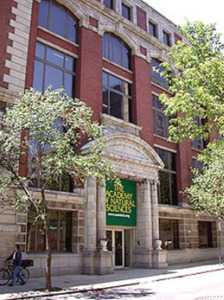
|
| The Academy of Natural Sciences |
School children grow up in Philadelphia with an image of the Academy of Natural Sciences as a place to visit dinosaurs. Indeed, it does have on display the first dinosaur skeleton ever to be discovered, as well as a number of others. However, only about a third of the building complex on Logan Circle is devoted to public museum displays. The rest is devoted to specimen storage, library and scientific work of the highest scientific eminence and value. In the scientific area, the most striking thing to a visitor is to notice how few windows there are. Scientists often spend their time looking through microscopes, so they don't care about windows. In a skyscraper business office that wouldn't be acceptable at all and the staff would all get the heeby-jeebies and quit. In the business world, the number of windows your office has is important, especially if they are corner offices, the best kind.
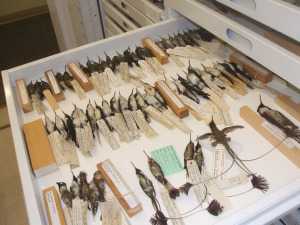
|
| Humming Birds |
In one small area of the museum is a set of ingenious metal cabinetry containing 200,000 bird specimens, including every one of the 10,000 known species of birds on earth. In fact, about a quarter of all the "type" specimens are found there with red tags on their feet. A type specimen is the first known and described specimen of that particular bird, ever. That's a round-about way of relating that this is where Ornithology, the study of birds, began. It also tells you that when bird skins are treated with arsenic salts, they last a very long time; a considerable number of the specimens in the cabinets were contributed by Audubon, himself. New bird skins are acquired at the rate of a thousand a year, related to the scientific studies which go on, studying bird diseases, genetic changes due to environmental changes, and pollution effects. The recent uproar about Avian influenza revolves around the tendency for bird diseases to undergo genetic changes themselves and become human diseases. A great many such bird diseases are maintained at the laboratory in case they are needed for a crash program of vaccine development. Environmentalists will be surprised to learn that the mercury content of bird feathers has actually declined in the past century.
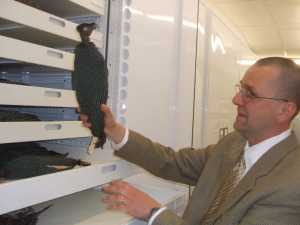
|
| Guinea fowl |
With a good guide you quickly grasp the attraction of this topic of birds and birding. There are huge condors, with six-foot wingspreads; and one-inch hummingbirds. Birds of every shape and coloring, reaching some sort of extreme with the Bird of Paradise from New Guinea. Owls and eagles, ducks and chickadees. Hummingbirds defy the usual sort of nets; every single little hummingbird specimen was obtained by shooting it with a special little gun. If you see a hummingbird in your garden, just imagine what skill it takes to shoot one.
The ornithology department maintains an active program of loaning bird specimens to scientists all over the world, although this activity has recently been affected by computerization of the catalog of specimens, resulting in a massive global internet conversation among ornithologists, sort of like a Facebook of a very special sort. For all this activity going on, the collection area is an eerily silent place.
And that's just birds, crammed into an organized space of, well, maybe fifty by two hundred feet, eight feet tall, fifty shelves per typical cabinet. Right next to it is the insect collection, perhaps taking twice the cabinet space. Insects are a lot smaller than birds, so each shelf has more specimens. That sounds like an awful lot of Latin names to try to remember. And a certain amount of danger, too. Several scientists died of arsenic poisoning before the full hazard was appreciated and contained.
Atlantic City, Brigantine and the N.I.H.
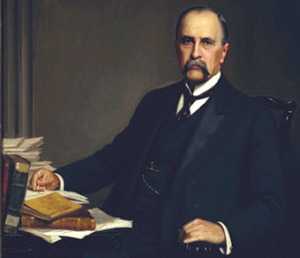
|
| Dr. William Osler |
It would only be honest to say that Atlantic City was a rundown mess after World War II, cheap, sleasey and dispirited. But for academic medicine during a period of thirty or forty years, one small nook of A.C. was the most exciting place in the whole world. Only during several days at the beginning of May, however. The reason it was so attractive to scientists was that beach hotels were cheap and dilapidated; Atlantic City probably contained the worst on the East Coast. The Haddon Hall was an exception, rather elegant and far too expensive for most physicians in training; research is a young doctor's game. The medical profession's annual beauty contest for medical research was headquartered in Haddon Hall next door to the Steel Pier, surrounded by hundreds of cheap lesser hotels. The professors all stayed at Haddon Hall, but few others could afford it. Indeed, resident physicians from Philadelphia mostly found it cheaper to commute from home for ninety minutes than to stay overnight, residents and fellows from more distant cities stayed in the dumpy hotels. Nobody in that age group had much money to spend, so the commuting Philadelphians didn't miss out on much nightlife at the shore by going home every night.
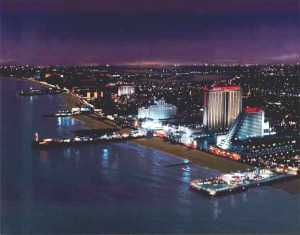
|
| New Atlantic City Skyline |
Before the spring meetings got popular after World War II, a hundred members of the most elite society of academic research professors on the East Coast assembled in Haddon Hall, all of them quite able to afford to stay in the headquarters hotel. This had been going on since William Osler founded it in 1885, at first in Washington, and then migrating to Atlantic City. As medical research began to flourish, the society grew a little, but at a pace too slow to keep up with the growth of medical scientists, so a second group of "Young Turks" formed a competitive society which met the next day, and ultimately a third group, the "Young Squirts", felt excluded by the old has-beens, and met on the third day of what eventually turned into a week-long parade of scientific presentations, each ten or twelve minutes long, starting before normal breakfast time, lasting until 10 PM, with occasional breaks. That is to say, the medical papers that everybody wanted to hear grew from thirty or forty a year to nearly a thousand. If a young fellow did well, the older professors would notice, and he would get employment offers. That kept the eminent older doctors around for the whole session and provided an informal ranking of the worth of the program. Everybody wanted to advance up the ranks of prestige, and this system roughly sorted them out. However, it was an exhausting experience just to sit through all that and listen; the old professors tended to drop out and go home a little early. No matter how many outstanding papers were clamoring to be heard, no one could endure more than a week of straining for attention. It was strictly forbidden to present a paper which had been published or presented anywhere else, so it was usually difficult to guess in advance whether a paper was likely to be exciting. You could go home early if you wanted to, but at the risk of missing the real blockbuster of the year, tucked away on the program with a bewildering scientific title. The younger wise-apples had a formula, that if one paper in three was outstanding, you were having a good meeting; you just had to grit your teeth and try to stay awake during the other two-thirds. Still, that got to mean that the reward for pursuing this grinding ordeal was to go home after learning about three hundred outstanding scientific advances that no one else knew about; knowing three hundred cutting-edge things that other doctors didn't know really did put you well ahead of the pack. Keep that up for ten or twenty years, and notable differences among colleagues would relentlessly emerge.
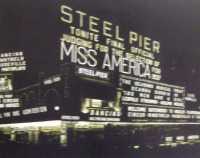
|
| Old Steel Pier |
From the lounge of the Haddon Hall, with non-members forced to stand in the back, the meeting moved to the 2000-seat movie theater in the Steel Pier, at about 1950. Things then came to equilibrium; the movie theater was never completely full. We were told there were seven or eight even larger auditoriums on the Steel Pier, but it was never necessary to move to them. The first four years I attended these sessions I was being paid no salary at all, and most of my contemporaries were only getting token amounts beyond room and board. The eminent professors who were real members of the top society would find their way to front-row seats where they could ask questions, having had a chat with colleagues at breakfast in the Haddon Hall. But they had once been impecunious, too, and wore their brand-new Ivy League plaid jackets rather uncomfortably. Doctors who (gasp) worked for drug companies also gave signs of affluence, but they tended to drift over to the barber shop and have a shoeshine, where they picked up the gossip for their employers. Over a period of fifty years, I can recall first hearing of the wonders of several new antibiotics, a strange chemical called cortisone which seemed to cure rheumatoid arthritis, the introduction of the birth-control pill, the introduction of polio vaccine, the first drugs in the treatment of tuberculosis, and a vast array of novel explanations for disease phenomena that had seemed mysterious for centuries. In those days, a year without a new medical miracle was a very lean year, indeed. During this interval, the basis for curing at least thirty common diseases was first presented at the Spring Meetings in A.C., and since then medical practice looks nothing like it did in 1947.
Gradually the audience changed, too. At first, the people presenting papers came from at most ten medical schools, and mutterings of discrimination could be heard. In fact, it was plainly true, because only about ten schools had any extra money to fund research. When this news reached the U.S. Senators from the Mid and Far West, federal research money started to be spread around more evenly, just like the distribution of Senators. It was the appointment of one of the members of the original small nest of clubs to the Directorship of the N.I.H., the National Institutes of Health in Bethesda, Maryland, which really got the research spigot to flow. The point man was James Shannon, who knew what was what in cutting-edge research, and he sat there in the audience making up his mind who was who. For all the time of his directorship and for long afterward, he enforced, really enforced, the rule of "no political influence in research grants". Lots of congressmen came to the N.I.H. with the news that their relatives had such-and-such a disease, and so they thought more money should be diverted to research in that area. Nothing doing. Shannon held the keys to the kingdom, and he knew it. He had a deft feel for how much money the research industry could usefully absorb, and then he went to Congress and demanded it. The purity of this process has frayed at the edges somewhat as the amounts of money grew to what is now thirty billions of dollars a year. Most experiments, unfortunately, fumble or fail, so a lot of money gets spent on blind alleys before someone gets it right. It takes a tough-as-nails idealist like Jim Shannon to survive the temptations of an N.I.H. Director, and among the temptations is just to give up and give out money indiscriminately to people who want to count all the grains of sand on the beach. If your idea was a good one, you got all the money you could possibly spend; if the idea was mediocre, in those days you got nothing at all. On the other hand, the estimation of overhead costs is something other mortals can quibble about. Shannon demanded and got about a third of the grant money to be given to the medical school administrations. That was barely enough in a research establishment emerging from the Depression of the 30s, and the World War. However, now that the pipeline is filled, it is increasingly doubtful that ten billion a year needs to go to administrators; the bean-counters took over, and the results are more open to criticism. After all, after someone finds a cheap cure for cancer, some disadvantages of perpetuating an aging retiree population start to emerge and may outweigh the arguments for spending quite so much doing it. That may well be what the advisors to President Obama are growling at, but for now, the example of his nose poked into the hornet's nest of favoring research for certain population (voter?) groups will restrain others who were once inclined to agree. After cancer is cured, perhaps then everything will seem different.
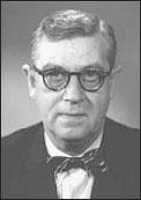
|
| Dr. James Augustine Shannon |
Well, let's tell one story out of many that could be told. Around 1965 there were two competitive polio vaccines rumored to be in the pipeline. Jonas Salk had an injection method, and Albert Sabin had an oral vaccine. Anyone who had watched children run shrieking from a needle knew that Sabin had the preferred method, but Salk got to Atlantic City two years earlier than Sabin. The auditorium was filled with rumors of very dubious precision to the effect that Salk had used unfair methods to get to the stage of public announcement. For example, it was growled he gave the vaccine to the Russians to test, but they were afraid of it and gave it to the Poles. Regardless of such scurrilous gossip, which is here repeated only to show how hysteria can occasionally agitate even scientists when Salk gave his paper at the Steel Pier, the standing ovation was thunderous. And so, as the meeting broke for dinner the crowds migrated over to a huge seafood restaurant named Hackney's and watched the new scientific hero get a little tipsy in public. That seemed to revive the rumors which became even less factual. But there is no doubt that by the time Sabin stood at the same podium and gave his presentation of the oral vaccine, the crowd had switched to his side, the ovations were unlike anything the scientists had ever heard. Anyway, as emotions now settle down in retrospection, we are all pretty happy that polio is nearly eradicated from all but a few corners of the earth, and these two men are both responsible for it. But so is Jim Shannon responsible for it, and he never got the ovations he deserved.

|
| Mr. Peanut |
When the gambling casinos came to A.C. the cheap boarding houses were swept away, doctors in the research were incidentally better paid, and the Spring Meetings migrated back to Washington. The dumps on the beach have been replaced by gleaming multistory hotels, the place looks much more prosperous. Doctors are in a position to know about the drug and alcohol addiction, the venereal disease and crime among the casino employees, and the personal tragedies among the gamblers. But anybody can see the new buildings and clean streets. When a group of eight of us took a nostalgic trip to revisit the place, no doctor even mentioned the idea of going in to drink and gamble -- even the suggestion was preposterous. So we wandered over to Brigantine where there appears to be a large retirement community, where gambling and drinking seem equally unlikely. The elementary school in which we heard a talk about the old days was splendid beyond anything I remember in an elementary school. Among the audience, the questions revealed there were many former employees of the old A.C., people who ran shops to sell salt water taffy, fudge and the like to crowds on the boardwalk. Some of them may have once driven Jitney buses or pushed sightseeing wheelchairs. But not one of them showed the slightest sign of recognizing that on the first weekend in May, every year, a crowd of nerdy-looking serious fellows would move into familiar boarding houses for a few days, remaining mostly invisible during daylight hours. That was the academic doctor crowd if anyone had bothered to ask, pouring into the Steel Pier movie theater, having the time of their lives listening to medical history being made. After a week they all went home, and nobody in A.C., later Brigantine, paid any attention to any of it. After all, A.C. is about salt water taffy, right?
Whither Alzheimer?
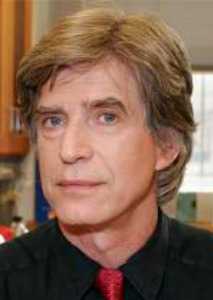
|
| Dr. John Q. Trojanowski |
The Right Angle Club was recently treated to a sophisticated movie and a polished presentation by Dr. John Q. Trojanowski, Professor of Geriatric Medicine at the University of Pennsylvania. Among other posts, he holds the Truman G. Schnabel, Jr. Chair, which particularly endears him to me since Nipper Schnabel was an old friend. Dr. Trojanowski has kindly given permission to use his slides on Alzheimer's Disease.
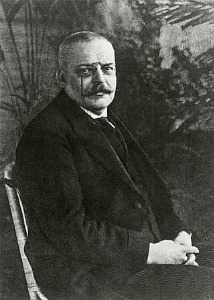
|
| Dr. Alois Alzheimer |
When Dr. Alzheimer published his description of the disease which bears his name, in 1906, it was treated as a rather esoteric or even insignificant accomplishment. The average life expectancy at that time was age 47, so although some people did live to an advanced age, most people didn't. A newly-identified disease which crippled and shortened the lives of old folks was pretty well brushed aside. Doctors were too busy treating tuberculosis, rheumatic fever, syphilis and typhoid fever -- diseases which were part of ordinary practice. As things turn out, however, life expectancy nearly doubled in the ensuing century, so both the number of old folks has vastly increased, and they are dying even later, disproportionately increasing the prevalence of Alzheimer's disease, to the point where it is now the sixth most common cause of death. At present, nearly half of people who achieve the age of 65 will eventually develop Alzheimer's, and most of them will die of it. It's a protracted fatal disease, requiring a great deal of expensive care. One rough rule of thumb is that when patients reach the point of being unable to recognize the spouse or nearest relative, they will probably still live another two years.
With conventional nursing care, utilizing home nursing aides, it will likely cost more than $50,000 to take care of any patient during a perfectly dreadful terminal experience. One of the more imaginative ideas for relieving this financial burden has been to store up credits for volunteer work as nursing assistants after retirement, but before infirmity, say between 65 and 85. Those credits could then be used later to pay for the care of that same volunteer when he or she becomes incapacitated. The tax authorities have been unsympathetic, however, fearing any system of barter undermines the income tax mechanism. Since there presently is a huge pool of unused labor in the early years after retirement, this idea should be revived, and at least given a trial as a pilot experiment.
Experience with trying to treat this growing epidemic brings out features which somewhat seem to support the idea of "intellectual reserves". Educated and intellectually active people tend to develop the condition less frequently, or at least later in life; aboriginal cultures develop the condition much younger than advanced ones, head injuries and sports which promote them provably increase the prevalence. It looks as though persons with greater educational attainments have some kind of reserve capacity to be used up before the disease finally overtakes them. And strange things happen; the incidence on the island of Guam is now only a tiny fraction of what it was a century ago. Unfortunately, all of these anecdotal experiences contain the chance that it is actually the early onset of the disease which lessens social skills, rather than the other way around. Unfortunately, exercise does not seem to improve cognitive functioning, although it improves other functions.
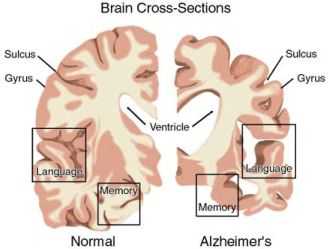
|
| What is Alzheimer's |
Naturally, there is a great hope for scientific improvement in the treatment of this condition. After all, the percentage of persons over the age of 80 who are disabled from any condition is only half of what it was in 1982. However, the most discouraging feature of Alzheimer's dementia is that it is a degenerative disease. The estimate is made that when the first symptom of Parkinsonism appears, roughly 40% of the substantia nigra has already been destroyed. That sort of observation leads to the very discouraging possibility that a new treatment for the condition, even one that is completely effective, may never do any patient's symptoms any good. At least, research workers in the field may have to give up the approach of treating patients to see if they get better because the damage has already been done. Very likely, vast numbers of apparently normal persons may have to be treated for years, in order to see whether the disease is eventually delayed in its onset. That's quite different from defining the value of a drug for pneumonia, where all you have to do is treat a hundred patients to see if it works. Delaying the onset of this disease would be no small achievement, however, because of the average age of the patients. A delay of five years in the onset would reduce the overall quantity of impaired persons by 50%. So, an effective drug for Alzheimer's would be enormously valuable, but it would be far more expensive to determine potential delays in onset, the potential toxicity of years of preventive therapy would be greater, and the public disappointment on behalf of existing patients would be something to deal with. All of these discouragements tend to inhibit drug manufacturers from spending vast sums to develop a treatment, particularly in an era where cost concerns are prominent. But we all better get used to it: delaying the onset of degenerative diseases is likely to be more expensive, and much more difficult to prove, than the medical miracles of say infectious disease we have grown accustomed to looking for.
Joseph Priestley, Shaker and Mover
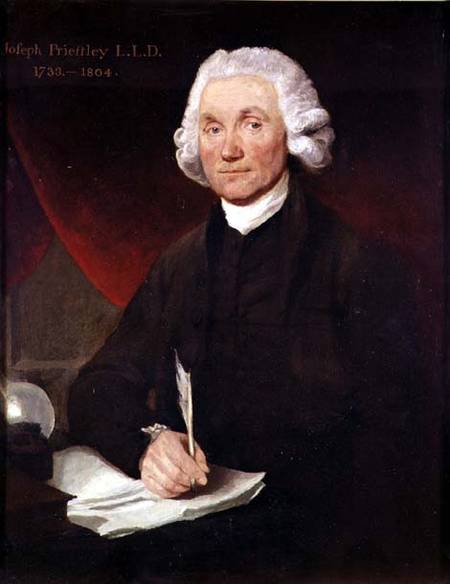
|
| Priestley |
Joseph Priestley, sometimes also spelled Priestly, is surely one of the more undeservedly neglected men of history. He has been called, with justice, the Father of the Science of Chemistry. He might also be called with equal justice, the father of the First Unitarian Church . The First Unitarian Church of Philadelphia, at 21st and Walnut, is the first and oldest Unitarian church and was indeed started at the urging of Priestley, whose principal residence was in Northumberland PA, at the confluence of the West and North Branches of the Susquehanna. Priestly wrote a scholarly work on the teachings of Jesus, which so captivated Thomas Jefferson that Jefferson wrote him the outline of another book that needed writing. Apparently, Priestley didn't have time, so in 1803 Jefferson wrote it himself, in the four languages he was fluent in, English, French, Latin, and Greek. Although those were simpler times, there have been few if any others who have told a President of the United States that he was just too busy to respond to a presidential request, particularly when the President could then find he had time to do it himself.
Priestley's theological teachings were based on scientific reasoning. They were highly controversial views, to say the least. He rejected the concept of a Trinity (he was a Calvinist minister, mind you), the divinity of Christ, and the immortality of the soul. Essentially, he rejected the concept of an immortal soul on the reasoning that perceptions and thought were functions of material structures in the human brain (Edmund O. Wilson's idea of Consilience is largely similar), and therefore will not outlive the cerebral tissue which produced them. In 1791, mobs burned his house in Birmingham, England, his patronage was revoked, and he hastily emigrated to Philadelphia. It isn't hard to see why these ideas were particularly unpopular with the Anglican church, which is probably the main reason England made him into a non-person, and his scientific ideas were denigrated as the product of other people.
That's too bad because he really was a scientist of immense importance. As a young man, he encountered Benjamin Franklin in England and was certainly a man after Franklin's heart. He noticed funny things about gases that rose from swamps and over mercury salts, and Franklin encouraged him to systematize and analyze his observations into theory. Although he called it anti-phlogiston, he had discovered oxygen. And then hydrogen, and nitrous oxide, and sulfur dioxide, and hydrochloric acid. Priestley really was the first organized and coherent scientific chemist, the Father of Chemistry. Franklin, Lavoisier, and Priestley became scientific friends, and enthusiastically exchanged ideas and observations, eventually leading to Lavoisier's fundamental principle: Matter is neither created nor destroyed, it only changes its form. In the end, it made no difference; Priestly had offended some pretty large religions, and nothing he did in chemistry was going to get much attention. Perceiving the value of the land at the confluence of rivers, he made his home for the last ten years of his life in Northumberland, Pennsylvania, now three hours drive Northwest, somehow managing to maintain an active scientific, political and theological influence worldwide. Visiting this rather sumptuous estate in a little river town is well worth a tourist visit. He died in 1804, just after his friend and kindred-religionist Thomas Jefferson became President of the United States.
Priestley's life can be summarized in one of his own most quoted remarks. "In completing one discovery we never fail to get an imperfect knowledge of others of which we could have no idea before so that we cannot solve one doubt without creating several new ones."
REFERENCES
| The Invention of Air: A Story of Science, Faith, Revolution,and The Birth of America, Steven Johnson ISBN: 978-1-59448-852-8 | Amazon |
Joseph Priestley of Northumberland, PA
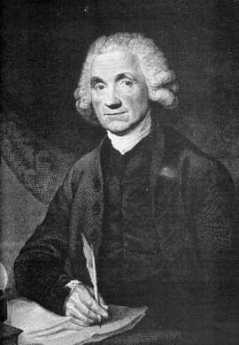
|
| Joseph Priestly |
There's one good thing about living near the confluence of two big rivers, and one very bad thing about it. The rivers provide transportation in three directions, but about once every twenty-five years the rivers rise astonishingly and threaten to carry everything away. That deposits rich topsoil, making it even more attractive for settlers to locate there. At what we now call Northumberland located on the junction of the North and West Branches of the Susquehanna, there is a monument marking off the flood levels of the past two centuries. Even the least of these floods must have covered a lot of ground, and the highest one is so far above the head of a visitor that it is hard to see how anything could have survived it. Right now, the little town of Northumberland is a burnished little jewel. One hopes the Army Corps of Engineers either has or soon will abate the potential flood danger. It would be interesting to know if flood insurance is available, just as a sign of how experts currently evaluate the risk. The Endless Mountains (that's really their name) stretching almost to Cooperstown, catch a lot of rainwater and snow and occasionally funnel it all down the North Branch to Northumberland. The West Branch is even bigger. Having observed the 1936 flood in Pittsburgh, I can testify it isn't an experience soon forgotten.
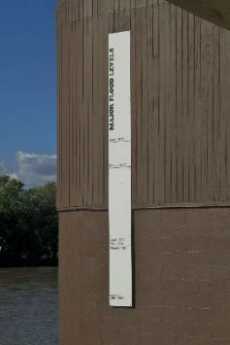
|
| Flood Levels |
It happens the most prominent resident of the area arrived there in 1794 and lived out the last ten years of his life as a widower. Joseph Priestley, an English dissenting minister had stirred up enough uproar to cause his house to be burned to the ground. No doubt, the English wanted to suppress any repetition of the French Revolution but were willing enough to be rid of a protege of Lord Shelbourne so the government made full restitution of the value of his property when he finally agreed to emigrate. Pennsylvania was chosen on the advice of his good friend Benjamin Franklin. He bought extensive land at the river junction and constructed what most people would describe as a beautiful mansion on reasonably high ground with a river entrance. Although it is built of wood and William Penn's Pennsbury was brick, there is a definite similarity. Priestley's house somehow seems more open and livable, although the outhouse reminds us that plumbing costs were moderate at the time. And furthermore, the original building survives as Pennsbury did not. The original plans for it were later discovered in England, and so it has been possible to make it what it used to be, outbuildings and all. Priestley and Lavoisier did not get along even though they share the honors for discovering Oxygen. Lavoisier was a rich aristocrat, while Priestley was a prominent member of the dissenting class with advanced ideas about democracy. It is said that many of the ideas Thomas Jefferson had about the natural rights of mankind were brought into sharper focus by his association with Priestley. Priestley was primarily a political theorist, acting in the role of a minister. He regarded his chemical experiments as a hobby, motivated by the hope of discovering a bridge between religion and science. The relationship between Priestley and Lavoisier was a strange one, but it had political conjunction as well as a scientific one. Priestley was driven to America by English Tories the same year that Lavoisier was guillotined by French revolutionaries.
Although oxygen had been discovered while Joseph Priestley was still in England, he discovered carbon monoxide in Northumberland, using retorts and scientific instruments he designed and sent to his friend Wedgwood to manufacture. He also devised the idea of carbonated water while he was here. For these as well as chemical methodologies he has been described, at least by Anglo Saxons, as the Father of Chemistry. Following what he considered to be his main occupation he meanwhile founded the Unitarian Church in America. In the little town at the Susquehanna forks, he was unable to establish a viable Unitarian congregation beyond a few followers who came to his home. So, he somehow found the energy to establish the First Unitarian Church in Philadelphia, at 21st and Walnut Streets. (Aside from its historic significance, the present church building is a distinguished work of architecture designed by Frank Furness). Meanwhile, he was very active in national politics; Jefferson's defeat of John Adams' reelection is often ascribed to his efforts.
His wife died of tuberculosis before they could move into the Northumberland plantation, but he lived there with his son and daughter-in-law for ten years, dying in 1804. The son was concerned with founding a utopian colony, but the wealthy daughter-in-law forced a return to England. The grandson generation returned to Northumberland, where the graveyard now has an impressive array of Priestley tombstones.
REFERENCES
| The Invention of Air: A Story of Science, Faith, Revolution,and The Birth of America, Steven Johnson ISBN: 978-1-59448-852-8 | Amazon |
Three-Mile Island

|
| Three Mile Island |
On a mud flat of the Susquehanna River called Three Mile Island, a nuclear energy plant had been built around 1970. The mud flat was in front of the entrance of the Swatara Creek, where Middletown the first town in the County had been laid out in 1732. Later on, the town of Harrisburg became the capital city of Pennsylvania, located a few miles north of the Swatara Creek at what had been called Harris's Ferry, later Harrisburg. For quite a while, Middletown and Hummelstown, also on the Swatara Creek, were the two main towns in the area, but the location of the state capital attracted railroads and steel mills to Harrisburg. One of its main claims to fame was that Confederate General Robert E. Lee was thought to have it as his primary objective for invading the North, frustrated in this goal of course by his defeat at the battle of Gettysburg. Meanwhile, Middletown has declined to a small country town and was therefore originally glad to have the industry of electricity generation located next to it. It's true the huge cooling towers loomed ominously, and huge plumes of evaporated water rose in clouds to be seen for miles. But Middletown slowly took on the look of a refurbished 18th Century town, fancy new restaurants and all, prosperous and waiting to be discovered as a tourist attraction. Maybe in time, it would be the next Williamsburg.
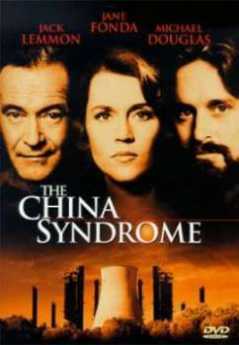
|
| The China Syndrome |
On March 28, 1979, some valve got stuck within Reactor Number Two. The plant had two reactors, each with a spare cooling tower so it looked as though there were four nuclear plants instead of two. Warning lights and whistles went off, and it is easy to imagine a general panic within the operators of the plant, especially since a popular movie, The China Syndrome had just been issued two weeks earlier, depicting an imaginary implosion of a similar nuclear plant with famous movie actresses running around screaming. It took about five days for the plant operators to make a preliminary assessment of the TMI situation, which did not seem as bad as it might have been. It would take six months to reach a final evaluation of just what had gone wrong, and why. In the meantime, almost anyone could say or imagine almost anything; no one could prove they were wrong. The local citizens held a referendum; they wanted all of the facility to be closed, permanently. Secretary of Health Gordon MacLeod wanted a somewhat more reasonable thing, which was large supplies of sodium iodide pills to be distributed to the populace to prevent the radioactive iodine content of escaped gases from being attracted to the thyroid glands of the population, especially children and child-bearing mothers. Unfortunately, he took the unforgivable step of criticizing the state government for not having stock-piled the pills, and the Governor fired him, thus demonstrating strong decisive action in an emergency. The news media were equally at sea because this was big news. When all was finally said and done, there was no evidence that anyone was injured as a result of the accident. More than thirty years later, there is still no sign that anyone was ever hurt.

|
| Hiroshima Explosion |
We might not have been so lucky, of course. When the Russian plant at Chernobyl had a worse accident in 1986, literally thousands of Ukrainians were sickened, and the death rate was appreciable. In Japan, the victims of the Hiroshima explosion were closely followed for many years, and the incidence of cancer of the thyroid among the survivors was truly frightening. However, after more decades elapsed, it was possible to determine that the overall death rate from thyroid cancer was not increased, suggesting these new cancers were not particularly malignant. But in a different set of circumstances, when the Chinese set off their tests of nuclear weapons, it became clear that these tests were followed in a few years by a world-wide epidemic of Hashimoto's Disease of the thyroid. Radioactivity in mushroom clouds is mainly radioactive iodine, with a half-life of seven days. Unfortunately, the clouds sail around the earth, eventually settling into the dirt on the ground. Grass grows there, and cows eat the grass. By this time, the radioactivity is much diminished, but the digestive systems of cows concentrate this weak radioactive iodine, which then gets into milk in a more active form. The kids drink milk and get Hashimoto's disease. Whether they will later get thyroid cancer and die of it remains unknown, but possibly not, in view of the Hiroshima experience. So, amidst a welter of conflicting evidence, it is still possible to say almost anything about nuclear power risks without fear of provable contradiction. It is only safe to repeat that radioactive iodine exposure doesn't do anyone any good.
Unfortunately, thirty years after the accident, we now all understand it would be a good thing to develop energy independence from Middle East sources; but we remain unsure just how unsafe we are willing to become in order to re-adopt nuclear energy. Since the accident at Three Mile Island, our government has made it impossible for a single atomic plant to be built in America. And the politicians are surely right about frightening public opinion on the topic. Just look at pretty little Middletown: it's moving toward becoming a dilapidated ghost town.
Without claiming any expertise in atomic energy production, it is possible to quote others to the effect that the hesitation of the politicians is no longer focused on the danger that a plant will explode. Rather, the real dispute is about the disposal of nuclear waste. No one wants it nearby. The French have built nearly sixty plants in the thirty years we have hesitated; how do the French dispose of nuclear waste? The answer seems to be that waste disposal is not a problem with the French methodology, but a new problem surfaces that the French approach generates a type of waste which is much easier for an undeveloped country to deploy as material for atomic bombs. So, the rumor commonly circulating is that this is really the main practical objection to constructing nuclear energy plants in the French style. As is true for the entire nuclear topic, the rumors outrun the evidence.
Thomas Say
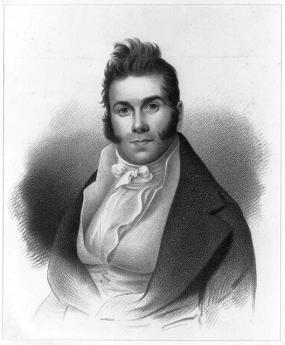
|
| Thomas Say |
When writing to a good friend and fellow naturalist about his exploits in American Conchology, the Philadelphia Entomologist Thomas Say assured his friend that "INSECTS are the great objects of my attention. I hope to be able to renounce everything else and attend to them only." And so he did, writing one of the most important books on the study of North American insects. Say's American Entomology transformed the study of American Natural History from the pastime of science-oriented gentlemen, into a legitimate scientific field.
Thomas Say was born on June 27th, 1787 into a respectable Quaker family, the same summer when men from the newly independent states were meeting for the Constitutional Convention. His father, Benjamin Say, a "fighting Quaker" during the revolutionary war, was a well-established pharmacist and apothecary. His mother was a descendant of the famous naturalist, John Bartram of Bartram Gardens in Kingessing. Say seems to have inherited the naturalist gene, and collected butterflies for his great uncle, William Bartram, as a young boy. Into adulthood, he remained uninterested in all subjects save Natural History.
Say's father, skeptical about his son's obsessive interest in bugs, attempted to set him up in the pharmacy business as a partner with a family friend and fellow naturalist, John Speakman. Unfortunately, both men were more interested in Natural History than business; their partnership failed miserably, leaving Say completely broke but with plenty of time to devote to his passion, Natural History.
This passion contributed to the founding of the Academy of Natural Sciences. Meeting in the houses of local naturalists, and even in Say and Speakman's chemist shop, a small group of young men set out to create an institution where they could collect, share and legitimate the study of Natural History. With Say present at the founding meetings, the Academy of Natural Sciences was established to stop the exportation of scientific research to Europe and establish an American scientific community. Patriotic fervor was particularly notable during the year of the Academy's founding, 1812.
The Academy's progress took a brief hiatus that summer to put a stop to what the new Americans viewed as threats to the young country's independence. Say joined the army and survived its bullets. By the end of the war, and with American economic independence intact, the Naturalists now continued their mission of establishing American intellectual independence. Elected the Conservator of the Academy, Say devoted his life to the maintenance and study of its collections. He is said to have lived in the rooms of the Academy on bread and milk (with an occasional chop or egg) and to have slept under the skeleton of a horse. Notoriously frugal, spending only 6 cents on food every day, Say bemoaned the hassle and expense of dining. He would rather be studying the wings of mosquitoes than wasting time with fancy dining.
During these early days of the United States, Thomas Say was quickly cast as a key member of America's varied and extensive expeditions to discover its largely unknown country. His first was a trip with fellow Academy members to Florida in 1817, a journey cut short by the threat of unfriendly local indigenous tribes. The group did manage to capture a few important species; Thomas Say wrote to a friend that Florida while "not flowing with milk and honey," was "abounding in insects which are unknown."
In 1819, Say was appointed head zoologist for the expedition of Major Long to the Rocky Mountains, where Say discovered and named not only insects, but animals as well, including the Columba fasciata Say, or fan-tailed pigeon. Several years later, in 1823, Say accompanied Long once again, this time on an expedition to the head of the St. Peter's River.
Back in Philadelphia, Thomas Say worked tirelessly to deepen the Academy's intellectual work, publishing many articles for the Academy's Journal on both entomology and conchology. He was also involved with the American Philosophical Society and became professor of Natural Sciences at the University of Pennsylvania. During this busy time, Say also managed to socialize among Philadelphia's upper crust, and is noted as having attended Caspar Wistar's weekly "soirees."
.jpg)
|
| Papilio Glacus from American Entymology |
His urban life did not last, however; Say found himself swept westward in a great tide of social idealism. Robert Owen, a Scottish social reformer, moved to the United States in hopes of establishing a community based on the principles of cooperation, brotherly love, and universal education through the absence of competition, and religious motives. Having purchased the property of the German "Harmonists" in Indiana, Owen persuaded nearly 1,000 people of varying background to help establish a Utopian society. Although Say had a strong democratic spirit, he was perhaps most interested in the move West for what it might offer him in the way of scientific discovery.
In 1826, with both MacClure and Owen, Thomas Say sailed down the Ohio River on what was called the "Boatload of Knowledge," a small ship carrying East Coast intellectuals to their Indiana paradise. Say was put in charge of the operation and named captain of the ship, perhaps due to his experience in the army more than a decade before. It was also on this boat ride to Indiana that Say met his future wife, Lucy Way Sistare, a prospective schoolteacher at New Harmony.
Despite this drastic move, Say remained much more concerned with his study of Natural History than any particular ideological movement, a fortunate enough attitude given the community's short life; after only two years the New Harmony project evaporated because of lack of organization and internal feuds between Owen and his various followers. Say was nevertheless able to use the move out West to his advantage and took part on an expedition to Mexico with William MacClure.
Although voices from the East Coast, and particularly the Academy, called him back, Say stayed in Indiana, publishing his two most famous works, American Entomology and American Conchology. He used illustrations composed over the years by young Titian Peale, son of Say's portraitist, Charles Wilson Peale, as well as Charles Alexandre Lesueur. Lucy Say, his wife, also helped to color the plates for their publication. These two works, and particularly American Entomology were praised abroad as real works of science and as proof the United States had "serious" scientists.
Say experienced relative peace and quiet during his final years in Indiana, a quiet spent in vigorous study of Natural History. However, after years of ill-health, of putting off food for study and his own well-being for that of others, Say died at the young age of 49 in 1834. He was buried at New Harmony, the grave marked with an epitaph capturing his unique passion for the Natural World:
Botany of nature, even from a child,
He saw her presence in the trackless wild;
To him the shell, the insect and the flower,
Were bright and cherished embers of her power.
In her, he saw a spirit life divine,
And worshiped like a Pilgrim at the shrine.
Elias Durand
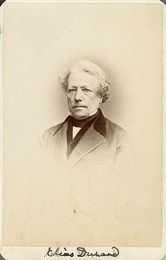
|
| Elias Durand |
Philadelphia has a long and bumpy history with the French, more or less paralleling the British wars with them. But when the guillotine threatened aristocratic necks, Philadelphia offered a sanctuary of new world enthusiasm and sophistication. A few years after the terror, during the reign of Napoleon Bonaparte, Americans scorned his monomaniacal approach to government, returning to the British disdainful view of Frenchmen. In another era, Philadelphia would change its view, displaying a prominent collection of sculptures by the famous French artist, Rodin. And in today's political climate, of course, the French and their socialist leanings are akin to the devil incarnate. It can not be denied, however, the French had a major influence on Philadelphia society and culture. Elias Durand, a former member of the Academy of Natural Sciences whose portrait hangs in the Library Reading room, was a French refugee whose love of Botany greatly expanded American understanding and knowledge of plant life in North America. Somehow, that seems appropriate for an educated Frenchman. But his achievements in commerce were at least as important to his adopted city as his intellectual ones.
The youngest of fourteen children, Durand was born in Mayenne, France in 1794. A passionate chemistry student, he studied pharmaceuticals in school where he was also introduced to the subjects of natural history, mineralogy, geology, and entomology. His rich education in both Mayenne and Paris expanded his interest in chemistry to include the interplay between the hard sciences and the natural world. In 1812, after studying in Paris, Durand joined Napoleon's army, where he served as a medic and "Pharmacien," overseeing the opening of hospitals and the care of wounded soldiers. Even while serving in one of France's most historic wars, Durand remained passionate about the world of plants, by some accounts even collecting plants during the notoriously bloody Battle of Leipzig.
When Napoleon's luck turned bad, Durand focused his attention back to chemistry. In 1814 he left the army and moved to Nantes, where he worked briefly as an apothecary, as well as a lecturer on Medicinal plants in the regional Academy. Durand would remain a teacher throughout his life, instilling those around him with a fascination and passion for the Natural Sciences.
Always a patriotic Frenchman, however, Durand rejoined Napoleon's forces during the general's final hurrah, the "100 days." After Napoleon sustained his ultimate defeat at the battle of Waterloo, Durand retired from military duties and focused once again on the study of pharmaceuticals. His earlier connections to Napoleon, however, led to some uncomfortable clampdowns on the young man's freedom; Durand left the country in disgust in 1816 at being forced to report himself to the police every morning. He sailed to New York in pursuit of a life free from politics and dedicated to his passions of botany and chemistry.
Durand was quickly welcomed into the homes of other French ex-patriots living in Boston and soon met ambitious and science-oriented men who encouraged the young chemist to stay in the country. Hearing there might be work with Dr. Gerard Troost, the first president of the Academy of Natural Sciences, Durand traveled by foot to the mid-Atlantic region. This adventure brought him into contact with local Native Americans, whom he found friendly, as well as local native colonists, whom he found less so.
After a long and arduous journey down the East Coast, Durand finally arrived in Baltimore, only to learn that Troost was not in need of an employee. He was, however, desperate for a companion, and after spending several weeks in Troost's company, Durand left to find work in Baltimore with increased enthusiasm for Botany and in particular native species of North America.
In Baltimore, Durand found work with Mr. Ducatel as a pharmacist and apothecary. He quickly settled into the business, gaining experience in the field and eventually marrying Mr. Ducatel's daughter. But after five years in Baltimore, with both his wife and his father-in-law had passed away, Durand left Baltimore to search for new opportunities.
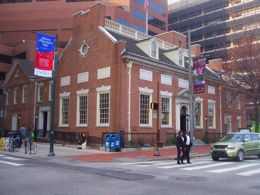
|
| Former Pharmacy at 6th and Chestnut |
He found them in Philadelphia. Perhaps because of the city's burgeoning field of Natural History or its emerging reputation as a medical town, Durand became committed to forging a career in Philadelphia. With the hope of opening a pharmacy in the finely decorated "European Style," Durand returned to France in 1825 to collect materials for this undertaking. Upon his arrival back to town, he set up a shop at 6th and Chestnut streets. His store quickly became world renown for its unique and finely produced medicinal pharmaceuticals, unique in its access to both old world and new world innovations.
Philadelphia proved to be a good move for the young Frenchman; in the next few years he married Marie Antoinette Berauld, a refugee from the St. Domingo Insurrection, and achieved election to the Philadelphia College of Pharmacy.
After his wife died in 1851, Durand gave up business to pursue the study of Botany. He was elected to the Academy of Natural Sciences in 1852, and during his membership published numerous articles and books on the botanical findings of expeditions to the American West and the Arctic. Durand also contributed to the study of Botany through the publication of several biographies about the lives of botanists Thomas Nuttall and Andre Michaux, the famous arborist. Durand's deep and lifelong appreciation for the study of Botany helped bolster the Academy's resources during his membership.
As Durand grew older, his French roots called him back to the homeland; in 1860 he returned to France, and finding the collection of North American specimens lacking in the Jardin des Plantes de Paris, determined to expand the collection himself. He returned to Philadelphia and spent the remainder of his life developing his collection of North American specimens with the help of his son. Eight years later, in 1968, Durand shipped his collection of 10, 000 specie herbarium to Paris where it was arranged in a special gallery named after him, the Herbia Durand. Much of Durand's remaining collection, however, was left to the Academy after his death.
After this long, varied and successful career in the world of Natural Science, Elias Durand died in his home on 9th and Broad Streets (sic) in 1873 at the age of 80. He had contributed greatly to the fields of Botany and helped to establish Philadelphia's respected reputation in the world of medicine. Although a Frenchman at heart, Durand remains a feather in Philadelphia's cap and an important face at the Academy of Natural Sciences.
Ball Lightning, Regular Lightning, and B. Franklin
Just about everybody knows that flying a kite in a lightning storm is too dangerous to consider, but hardly anyone appreciates the enormous scientific significance of what happened at 10th and Chestnut Street in 1752. Benjamin Franklin discovered electricity, essentially explained it, displayed its commercial value with lightning rods (but never patented or profited from them), and received the acclaim of the scientific community which would have won him a Nobel Prize if such a thing had existed then. It's true this didn't happen overnight; in many ways, he made the clinching demonstration on the shores of France. Something called the torpedo fish lives there, and Franklin gathered a group of friends holding hands in a circle, demonstrating the electric shock started with the fish and traveled around the circle. Out of this appreciative circle of scientists emerged his rightful reputation as a scientist of the first rank, soon to be the most famous American in the world.
But while millions of people had observed lightning flashes before Franklin connected one to a Leyden jar, those millions were merely content to go inside the house before it started to rain. Millions more still think of the whole episode as a quaintly stupid thing to do, without much scientific or practical value. Dangerous it was indeed, and it knocked young Franklin for a loop at another time and killed several other people who tried to repeat it. But to grasp the scientific feel of it, let's put yourself in Ben's shoes. Let's look at a probably related issue, called ball lightning.
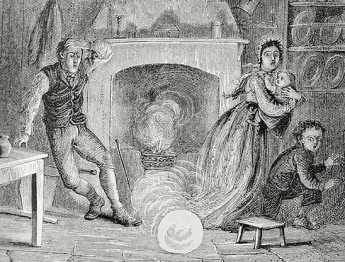
|
| Ball of Lightning |
Ball lightning is relatively uncommon, but some chronicler has calculated that about a half of one percent of the world's population has observed it. Counting from the beginning of history, that means a lot of ball lightning. Let's describe it here in the words of two Philadelphians who have actually seen it. One lady describes that she was in her kitchen on the Main Line during a thunderstorm when a big ball of light about the size of a basketball bounced through the door and sat on her stove for at least a full minute. It didn't give off much heat, didn't explode, and didn't smell bad. Although she was badly shaken emotionally, she doesn't remember anything much more. It just went away.
And another Philadelphian was on an airplane in a thunderstorm, back in the days when planes mostly flew below the clouds. A smaller blob of ball lightning appeared from nowhere and rolled down the aisle. Although no one kicked it or did anything else stupid, it created its sensation and then was gone.
A student of this matter says that although ball lightning is comparatively rare, it does occur often enough for extensive credible descriptions to exist. The size is most commonly between that of a pea and a sofa. It is not reported to give off much heat, usually but not invariably appears during a thunderstorm. Ball lightning appears to favor appearances over the ocean, and surfaced submarines seem over-represented among reporters of it. By report, the ball usually disappears with an explosion which does not sound like thunder but leaves behind a sulfurous odor. People who physically tangled with it, have been killed.
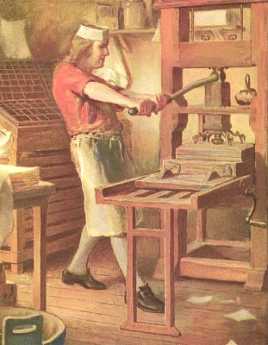
|
| Young Franklin and Print Press |
From the descriptions of crowds of people surrounding some of them, it seems unlikely these phenomena are merely visual hallucinations induced by lightning strikes, as has been suggested by some. And just what it would feel like to be that close to astronomical black holes, has not been reported by any survivors. Black holes are found scattered all over the universe, so there is no reason small ones couldn't appear on the Main Line, but it would seem likely they would be surrounded by a turbulent force field of some kind. Lots of other theories have been propounded, but haven't developed much scientific traction. In short, the state of ignorance about ball lightning today is about as total as about regular lightning bolts in the Eighteenth century.
So, there you are, a mysterious natural phenomenon which everybody ignores, just waiting for some amateur to get curious enough to devise a simple experiment to explain it. The remarkable thing about the discovery of electricity was not that it was a problem crying out for a solution, or a dangerous dragon needing to be slain. It was just something that everybody noticed, and everyone ignored. What was remarkable about this episode was not the nature of the phenomenon, but the unusual nature of the curiosity of a local printer named Ben.
Nanoparticles: The Dwarfs are Coming
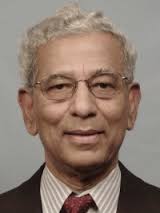
|
| Professor Shyamelendu Bose |
Professor Shyamelendu Bose of Drexel University recently addressed the Right Angle Club of Philadelphia about the astounding changes which take place when particles are made small enough, a new scientific field called nanotechnology. In one sense, the word "nano" comes from the Latin and Greek for "dwarf". In a modern scientific sense, the nano prefix indicates a billionth of something, as in a nanometer, which is a billionth of a meter. Or nanotubes, or nano calcium, or nano-anything you please. A nanometer is likely to be the dominant reference because it is around this width that particles begin to act strangely.

|
| Nanoparticles |
At this width, normally opaque copper particles become transparent, the cloth becomes stain-resistant, and bacteria begin to emit clothing odor. Because the retina is peculiarly sensitive to this wavelength, colors assume an unusual brilliance, as in the colors of a peacock's tail. The stable aluminum powder becomes combustible. Normally insoluble substances such as gold become soluble at this size, malleable metals become tough and dent-proof, and straight particles assume a curved shape. Damascus steel is unusually strong because of the induction of nanotubes of nanometer width, and the brilliance of ancient stain-glass colors is apparently created by repeated grinding of the colored particles.
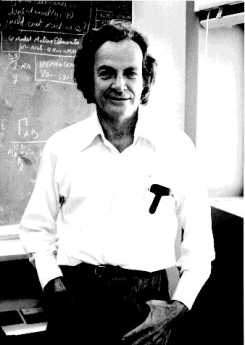
|
| Richard Feynman of Cal Tech |
Practical exploitation of these properties has almost instantly transformed older technologies and suggests the underlying explanation for others. International trade in materials made with nanotechnology has grown from a few billion dollars a year to $2.6 trillion in a decade, particularly through remaking common articles of clothing which were easily bent or soiled, into those which are stain and water resistant. Scientists with an interest in computer chips almost immediately seized upon the idea, since many more transistors can be packed together in more powerful arrangements. Richard Feynman of Cal Tech seems to be acknowledged as the main leader of this whole astounding field, which promises to devise new methods of drug delivery to disease sites through rolling metal nanosheets into nanotubes, then filling the tubes with a drug for delivery to formerly unreachable sites. Or making nanowires into various shapes for the creation of nano prostheses.
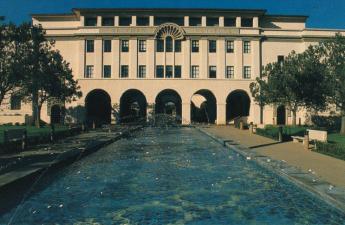
|
| Cal Tech on Los Angeles |
And on, and on. At the moment, the limitations of this field are the limitations only of imagination about what to do with it. For some reason, carbon is unusually subject to modification by nanotechnology. It brings to mind that the whole field of "organic" chemistry is based on the uniquenesses of the carbon atom, suggesting the two properties are the same or closely related. For a city with such a concentration of the chemical industry as Philadelphia has, it is especially exciting to contemplate the possibilities. And heartening to see Drexel take the lead in it. There has long been a concern that Drexel's emphasis on helping poor boys rise in the social scale has diverted its attention from helping the surrounding neighborhoods exploit the practical advances of science. The impact of Cal Tech on Los Angeles, or M.I.T on Boston, Carnegie Mellon on Pittsburgh, and the science triangle of Durham on North Carolina seems absent or attenuated in Philadelphia. We once let the whole computer industry get away from us by our lawyers diverting us into the patent-infringement industry, and that sad story has a hundred other parallels in Philadelphia industrial history. Let's see Drexel go for the gold cup in this one -- forget about basketball, please.
Evo-Devo
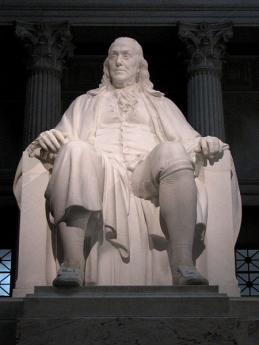
|
| The Franklin Institute of Philadelphia |
THE oldest annual awards for scientific achievement, probably the oldest in the world, are the gold medals awarded by the Franklin Institute of Philadelphia for the past 188 years. Nobel Prizes are more famous because they give more money, but that in a way involves another Philadelphia neighborhood achievement, because Nobel's investment managers have run up their remarkable investment record while operating out of Wilmington, Delaware. In the past century, one unspoken goal of the Franklin Institute has been to select winners who will later win a Nobel Prize, the actual outcome more than a hundred times. That likelihood is one of the attractions of winning the Philadelphia prize, but in recent years some Nobel awards have acquired the reputation of being politicized particularly the Peace and Literature prizes. Insiders at the Franklin are positively fierce about avoiding that, so the Franklin Institute prizes have become known for recognizing talent, not merely fame.
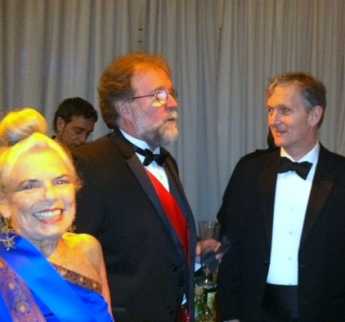
|
| Dr. Jan Gordon, Dr. Sean Caroll, and Dr. Cliff Tabin |
Within Philadelphia, the annual awards ceremony is one of the four top social events. The building will seat 800, but reservations are normally all sold out before invitations are even put in the mail. A major source of this recent success is clear; in the past twenty-five years, the packed audience is a star in the crown of Dr. Janice Taylor Gordon. This year, she hurried back from a bird-watching trip in Cuba, just in time to busy herself in the ceremonies where she sponsored Dr. Sean Carroll of the Howard Hughes Foundation and the University of Wisconsin, for the Benjamin Franklin medal in the life sciences. Carroll's normal activities are split between awarding $80 million a year of Hughes money for improving pre-college education from offices in Bethesda, Maryland, and directing activities of the Department of Genetics in Madison, Wisconsin. His prize this year has relatively little to do with either job; it's for revolutionizing our way of thinking about evolution and its underlying question, of how genes control body development in the animal kingdom. Evolution and Development are academic terms, familiarly shortened to Evo-Devo.
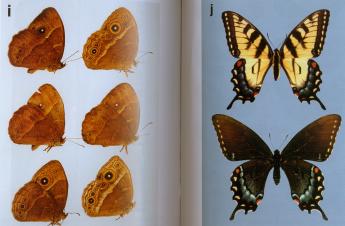
|
| Dr. Carroll's Butterflies |
My former medical school classmate Joshua Lederberg, also a resident of Philadelphia, was responsible for modern genetics, demonstrating linkages between the DNA of a cell, and the production of a particular body protein. For a time it looked as though we might confidently say, one gene, one protein, explains most of the biochemistry. In the exuberance of the scientific community, it even looked as though deciphering the genetic code of 25,000 human genes might explain all inherited diseases, and maybe most diseases had an inherited component if you took note of inherited weaknesses and disease susceptibilities. But that turned out to be pretty over-optimistic. Lederberg got into an unfortunate scientific dispute with French scientists about bacterial mating and now appears to have been wrong about it. But the most severe blow to the one gene, one protein explanation of disease came after the NIH spent a billion dollars on a crash program to map out the entire human genetic code. Unfortunately, only a few rare diseases were explained that way, at most perhaps 2%. Furthermore, all the members of the animal kingdom turned out to have pretty much the same genes. Not just monkeys and apes, but sponges and worms were wildly different in outward appearance, but substantially carried the same genes. Even fossils seem to show this has been the case for fifty million years. Obviously, animal genes have slowly been added and slowly deleted over the ages, but in the main, the DNA (deoxynucleic acid) complex has remained about the same during modest changes in evolution. Quite obviously, understanding the genome required some major additions to the theory's logic.
In late 1996, three scientists met in Philadelphia for a brain-storming session. Sean Carroll had demonstrated that mutations and perhaps an evolution of the wing patterns of butterflies and insects took place during their embryonic development, and seemed to be controlled by the unexplored proteins between active genes. Perhaps, he conjectured, the same was true of the whole animal kingdom. Gathered in the Joseph Leidy laboratory of the University of Pennsylvania, the three scientists from different fields proposed writing a paper about the idea, suggesting how scientists might explore proving it in the difficult circumstances of nine-month human pregnancies, in dinosaurs, in deep-sea fish and many remote corners of the animal kingdom. Filling yellow legal pads with their notes, the paleontologist (fossil expert) Neal Shubin of the University of Pennsylvania, genetic biologist (Sean Carroll of Wisconsin), and Harvard geneticist Cliff Tabin worked out a scientific paper to describe what was known and what had to be learned. The central theme, suggested by Carroll, was that evolution probably takes place in the neighboring regulatory material which controls the stage of life early in the development of the fetus, and these regulatory proteins consist of otherwise inactive residual remnants of ancient animals from which the modern species had evolved. As the fetus unfolds from a fertilized egg into a little baby, its outward form resembles fish, reptiles, etc. And hence we get the little embryonic dance of ancient forms morphing into modern ones. In deference to the skeptics, it would have to be admitted that the physical resemblance to adult forms of the ancient animals is a trifle vague.
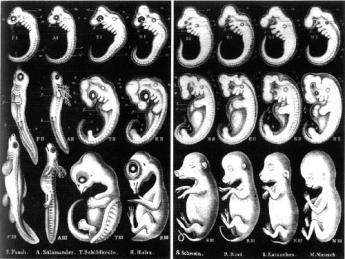
|
| Haeckel's drawings of vertebrate embryos, from 1874 |
Embryologists have long argued about Ernst Haeckel's incantation that "Ontology recapitulates phylogeny", which is a fancified way of saying approximately the same thing. Darwin's conclusion was more measured than Haeckel's and explanations of the phenomenon had been sidelined for almost two centuries. But it seems to be somewhat true that fossils which paleontologists have been discovering, going back to dinosaurs and beyond, do mimic the stages of embryonic development up to that particular level of evolution, and might even use the same genetic mechanism. The genetic mechanism might evolve, leaving a trail behind of how it got to its then-latest stage. Borrowing the "Cis" prefix ("neighboring") from chemistry, these genetic ghosts have become known as Cis-regulatory proteins as the evidence accumulates of their nature and composition. Growing from the original three scientists huddled in Shubin's Leidy Laboratories in 1996, academic laboratories by the many dozens soon branched out, dispatching paleontologists to collect fossils in the Arctic, post-doctoral trainees to collect weird little animals from the deserts of China, and the caves of Mexico, everywhere confirming Carroll's basic idea. Even certain forms of one-celled animals which occasionally form clumps of multi-celled animals have been examined and found to be responding to a protein produced by neighboring bacteria which induces them to clump -- quite possibly the way multi-cellular life began. Many forms of mutant fish were extracted from caves to study how and why they developed hereditary blindness; the patterns of markings on the wings of butterflies were puzzled over, and the markings on obscure hummingbirds. The kids in the laboratory are now having all the fun with foreign travel, while the original trio finds themselves spending a lot of time approving travel vouchers. Many fossils of animals long extinct have been studied for their evolution from one shape to another, especially in their necks, wings, and legs. Some pretty exciting new theories emerged, and are getting pretty well accepted in the scientific world. At times like this, it's lots of fun to be a scientist.
Bill Gates Gets a Medal
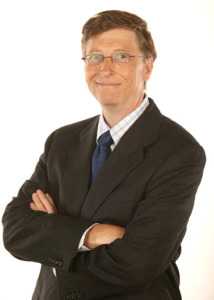
|
| William Henry Gates, III |
Bill Gates was once the richest man in the world. He may still have that honor, although it would be hard to say just where he stands now that he has established his charity foundation and changed jobs at Microsoft Inc. Instead of CEO, he's now Chairman and Chief Software Architect, a title so unique that its day to day meaning is obscure. If anyone cares about ranking billionaires, it would be hard to see why they do, since even one billion dollars is hard to spend in one lifetime. But it is interesting to speculate on why the Franklin Institute chose him as its scientific awardee, and why that was an insightful choice. And it is furthermore interesting to speculate on what motivated him to do what he did in life. He may not agree, but by this time he must be accustomed to having the whole world speculate on what they would do if they had his wealth, something the whole world seems to think would be a fine outcome.
The Franklin Institute is known for its interest in science, and of course, it is interested in preserving the spirit of Benjamin Franklin, who never went past the second grade but became the greatest scientist of his age. That's not the same as dropping out of Harvard because of better things to do with his time, but it has a certain kinship. Both Gates and Franklin appear to have spent a lot of time in science because they liked science, and both gave away a lot of money to charity, even though they both quite obviously liked money a lot, too. Both men retired in their 40s, but both of them sort of kept their hands in. Neither of them seems to have been able to tolerate idleness. There were appreciable differences between them as well, but enough similarities to portray them both as strikingly different from the sort of person who typically spends a lifetime as a scientist, obediently following the rules. In spite of all that, however, how does the Franklin Institute justify giving its top award to a businessman?
Since most of the people active in the Institute are residents of the Philadelphia area, it's reasonably easy to get an idea of the thought process without quoting anyone. If the Nobel Prize had been available in 1790, its present rules would have excluded Franklin. There's still no Nobel Prize assigned to eminent achievement in electricity, so the inventor of electricity might well have had some trouble getting past the nominating committees. Perhaps the 1776 founder of the American diplomatic corps might well have been able to wangle it, had he tried hard enough, and there had been enough women on the committee. So we must let that thought rest. The Franklin Institute first asks what is the most exciting field in science today, and then asks who is the most influential person in the field. Franklin would have won in 1790, and if you agree that computer science rules science today, you would have to give the prize for computer eminence to Gates. Apple and Google are coming right along, but Bill Gates was there first.
There is another line of reasoning to be considered here, one which includes the restlessness of some more conventional scientists seeing Gates honored in this way. He actively sought money for his achievements; the honor wasn't enough for him. Back in the early days of the computer, what ruled was the spirit of the gifted amateur, let's say the tradition of the wealthy English gentleman who tinkered. The early programs of personal computers were designed by the self-taught amateur who stayed up all night figuring out how to do things, and then proudly made an announcement at the local user's group. Magazines were published so amateurs could exchange discoveries; it was lots of fun. Gradually these support structures disappeared, supplanted by commercial software for a fee. Eventually, even the amateur-friendly languages were deleted, and ways were found to charge for later versions. Over the course of twenty years, amateurs by the thousands gave up the game and were replaced by millions of ordinary users.
In the early days, I was one of those enthusiastic amateurs, wrote lots of small programs for the use of myself and friends, for the good of the Order. From time to time, I wrote a piece of software that seemed more than slightly valuable, and I thought of selling it. For years I held back from such temptations, partly because of the nuisance involved, but mostly because of what I feared my friends would think of me for such crass behavior. And then, one day the light dawned on me. If people weren't willing to pay for the software, it couldn't be worth much. If it was indeed a valuable contribution to their work, they ought to help support me while I did some of the work for them. After all, money is the standard of value in our society, and a convenient means of exchange; there is nothing evil or demeaning about a free exchange between consenting adults. They want the software more than they want the money, that's all. If I charge too much they will refuse to buy; if I don't charge enough, I will starve to death. Meanwhile, the software industry with Microsoft leading the way flourished and got rich doing a lot of good for the world. It soon became clear that huge expenditures would need to be made to make the computer usable by just plain folks, but in return for that risk, hundreds of millions of school children, businesses and even barefoot citizens of developing third-world countries are now using the computer in their daily lives. Mass production brought down the costs of even the hardware, which at one time cost millions of dollars per machine. Bill Gates got rich on this revolution, but even his riches were a paltry fraction of the world benefits, whatever his original motives may have been, and no matter how much guilt he may now feel. Forget about his money. His impact on the world was stupendous.
There's a deeper level to this. We are rapidly reaching the point where nearly half of the nation works for non-profit concerns. It depends a little on which occupation is under discussion, but more than half of union members ( a group that is not shy about advancing its personal interests) now work for the government on some level. Add in the children who have not yet entered the workforce, and the retirees who have left it. If you count them, you can make a case that only a minority of Americans work for a profit right now, so their sympathies for-profits are therefore pretty weak. To them, the shift from non-profit to for-profit (like Bill Gates at Microsoft) is morally going the wrong way on a one-way street. The private economy encounters slander and epithets when they suggest privatization of public services, such as schools and postal delivery, to say nothing of policing and tax collection. These decisions in any rational environment ought to be made on which is the cheaper way to perform them since the implication that private operations are more corrupt than public ones has long since lost the argument of being obvious. Unfortunately, we are on our way to abandoning the scientific method of determining relative values, supplanting it with the judgment of fifty-nine Senators plus the Vice President, of five out of nine Supreme Court Justices. The marketplace is being denounced; what you hear is really the denunciation of the scientific method of determining truth.
We even have a glaring example amidst the ruins of the present financial mess, largely being mislabeled. Lehman Brothers were brought down by general denunciation, facilitated to some degree by the unattractive personal qualities of some of its leaders. But Lehman had discovered an important feature of globalization, which had lifted two billion Chinese and Indians from poverty. When a large international firm makes components in one country and assembles them elsewhere, it just does it. But when smaller firms make one piece and some other firm assembles pieces in another country, the components are bought and sold. There's a significant transaction cost in all this, not the least of which is borrowing the money for a short period of time to finance the inventories. On the surface of it, this sounds considerably more expensive than managing the manufacture within a single large international firm. However, Lehman figured out that borrowing money for a few days was more natural and cheaper if the money is borrowed short-term from a money-market fund; exploiting this idea, they quickly ran their business to many billions of dollars. Although the global revolution would scarcely have been possible without it, Lehman managed to keep its business secret from others long enough to give the appearance they were loaning without borrowing. A financial market in panic withdrew its investments from Lehman and brought it down. We are now left with the question, is globalized manufacture really cheaper than confining manufacture within a single country, or at most within a single international corporation? No doubt, the answer at any given time depends on a multitude of factors, but the financing of inventories is certainly one of them. No matter how it turns out, it will be a pretty close call, as all of the arguments about privatization which it strongly resembles. We cannot afford to have economic decisions of this magnitude depend on faulty reasoning, derived from ideology about the motives of private versus public reimbursement.
American Chestnut Trees
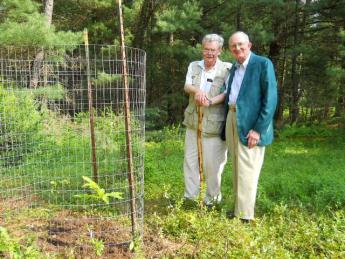
|
| American Chestnut tree |
RECENTLY, John Wenderoth of the Tyler Arboretum visited the Right Angle Club of Philadelphia, bringing an astounding account of the triumph, near-extinction, and revival of the American Chestnut tree. The Tyler Arboretum, and this man, in particular, is at the center of the movement to rescue the tree, although the modern Johnny Appleseeds of the movement seem to be a Central Pennsylvanian named Bob Leffel, and a geneticist named Charles Burnham. Together, they had the vision and drive to enlist a thousand volunteers to plant seedlings in Pennsylvania; and there are many other volunteer groups in other states within Appalachia. About 45,000 Chestnut hybrids have been planted, surrounded by wire fencing to protect the new trees until they grow too tall for deer to reach the leaves. Here's the story.
In 1904 it was estimated that a fourth of all trees in the Eastern United States were American Chestnuts. The tree typically grew to eighty feet before permanent branches took over, so the shading and tall pillars of tree trunks gave the forest a particular cathedral-like distinctiveness, much celebrated by such authors as James Fennimore Cooper. The wood of the American Chestnut tree is rot-resistant, so it was favored by carpenters, log-cabin builders, and furniture makers. It once was a major source of tannin, for leather tanning. The nuts were edible, but it has been a long time since they were available for much eating. The chestnuts you see roasted by sidewalk vendors are primarily Chinese Chestnuts, which actually come to us from South Korea. The Buckeye, or horse chestnut, produces a pretty and abundant nut but is too bitter for most tastes. For whatever reason, a fungus was first discovered to infect the chestnuts of the Bronx Zoo in 1905, attracting the attention of Teddy Roosevelt and his Progressive naturalist friends, but to little avail. The fungus (Cryptomeria parasitic) enters the tree through cracks in the bark, flourishes in the part of the tree which is above ground, leaving the roots undisturbed. Ordinarily, when this sort of thing happens, the roots send up shoots which keep the tree alive and flourishing. Unfortunately, the abundant deer of this area quickly nipped off the shoots as they appeared, and finally, the trees died. It took only a decade or so for this combination of natural enemies to wipe out the species, and today it is unusual to see lumber from this source. The forests of Chestnuts have been replaced by other trees, mostly oaks. The Chinese chestnut, however, proved to be resistant to the fungus, even though it does not grow to the same height.

|
| Chinese Chestnuts |
After many futile but well-meaning efforts to save the trees by foresters, friends of the American Chestnut tree turned to geneticists. The goal was to transfer the fungus resistance gene from the Chinese Chestnut to a few surviving American Chestnuts. It took six or seven generations of cross-breeding to do it (four generations of seedlings, then crossing the crosses, then weeding out the undesirable offspring), but eventually, the Tyler Arboretum was supplying truckloads of seedlings to the volunteers to plant in likely places. It's going to take many years for the seedlings to grow in sufficient numbers to make an impact on our forests, and eventually on our carpenters, but that effort is underway with gusto. If anyone wants to volunteer to join this effort, there appears to be room for plenty more people to help.
What's a Ribosome? Who is Joachim Frank?
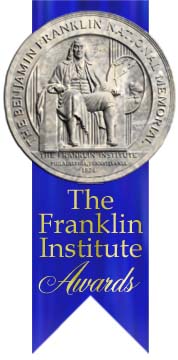
|
| The Franklin Institute Award |
Every year for many years, the Franklin Institute has been picking eminent scientists, and awarding them prizes. It has already selected over eighty awardees before they won Nobel Prizes, searching out talent, not merely fame. Albert Einstein, Thomas A. Edison, Madame Curie, Bill Gates and a host of other famous scientists have been awarded Franklin Institute Prizes, going back longer than the Nobel Prizes themselves for many years. The awards dinners are usually held in the Spring of the year, and the Institute is completely filled with attendees. In fact, for the past few years the seats have been completely sold out before the invitations are in the mail. It's expensive to attend, the food is outstanding, and it's certainly the most prestigious scientific event of the Philadelphia social season. However, there's something you need to know. The awardees give only the briefest of speeches at the dinner; a full presentation of their scientific work is given on a different day, usually the day before the dinner. If you really have scientific aspirations, we expect to see you at the seminar, where the most eminent scientists the Institute can find explain their work in full scientific detail. At the seminars, they show the audience very little mercy, although the cupcakes and coffee are pretty good.
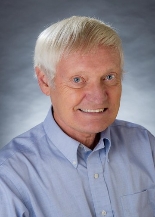
|
| Joachim Frank |
This year, the most astonishing life scientist was Joachim Frank. He's now on the faculty of Columbia University, but he originally comes from Germany, and did most of his scientific work at General Electric in upstate New York. Much or most of that time was spent taking (electron) photographs of a single molecule, the ribosome, at short intervals and from many different angles. You really have to believe in what you are doing, to take 80,000 photographs of a single molecule. But putting them together amounts to constructing a movie, and a movie of one molecule in action tells you a great deal about what the molecule is doing. That's assuming you believe the molecule is moving around doing something, which is an insight that most of us wouldn't even think of. A ribosome molecule is a rather large one, covered with knobs which are thinly attached to the main molecule. The knobs waggle around on their narrow attachments, more or less in continuous movement because of the "Brownian movements" of the internal atoms. As soon as microscopes got good enough to see molecules this small, it was clear that the electrons jiggle because the cell constituents are internally composed of atoms, but it was never clear what purpose was served by jiggling the atoms.
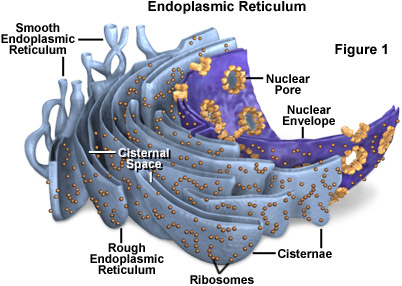
|
| Endoplasmic Reticulum |
By watching the synthetic movies derived from photographing the ribosomes, it eventually became clear that the knobs were jiggling on the surface of the ribosome in a purposeful way. And eventually it emerged that the ribosome was constructing ribbons of protein molecules in a way that resembled a zipper, using messenger RNA as the template. The RNA in turn was an expanded, or decoded, version of DNA in the cell nucleus. It was originally believed that RNA was just an expanded version of DNA, but chromosomes contain many instructions for different versions of RNA to emerge from a single DNA. Essentially, the ribosome then make many copies of RNA, once the particular expanded version has been selected and decoded.
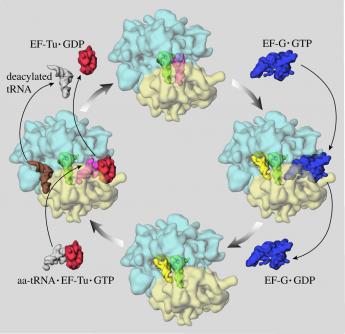
|
| Ribosomes |
You can get some idea of what cellular life is all about, by learning that every cell has hundreds of ribosome molecules strung out on a sort of net, called the reticulum. Every cell of everybody's body, or dinosaur body, or leaves on every tree, is full of a great many zippers, all busily churning out wads of duplicate proteins. And most cells are made up of proteins, doing something or other to neighbor proteins. Presumably, most diseases consist of abnormally modified proteins, and future drug therapies will require huge vats of modified proteins, calculated to dilute, modify or supplant abnormal ones. Looking back on centuries of chemistry experiments with small molecules, we can easily imagine that the past history of drug chemistry is only a minute happenstance in an environment which is largely made up of big proteins. Chemical boutiques redesigning and modifying new RNA proteins are easily imagined, and Joachim Frank has certainly discovered the elements of how to make such new drugs, by the ton.
Bring Your Own Hammer
Stonehenge in England is a ring of big stones standing on the edge, but only recently has it been discovered that they chime when you hit them with a hammer. The British didn't discover the phenomenon, however. Long ago the Quakers of Pennsylvania knew they had ringing rocks in a moraine dumped at the edge of a receded glacier in Bucks County. The County has made it a recreation park which is mostly deserted, except when a drove of cars appears, bearing dozens of Cub Scouts or other excursionists.
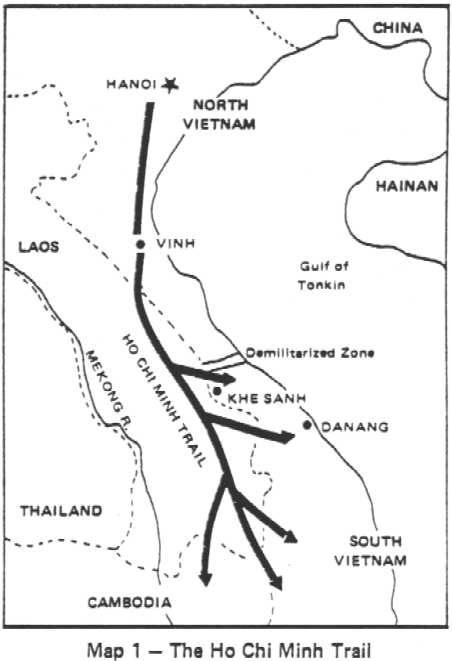
|
| Ho Chi Minh Trail |
Just what makes these boulders chime when you hit them with a hammer, isn't entirely clear. It's certainly a good topic for a geologist to use for a thesis, but right now none of the visitors to the park cares very much. It can easily be seen that the moraine marks the edge of the fertile plain surrounding Philadelphia, to the north of which the ground breaks up and has mining as its main industry. The farms suddenly become smaller and less prosperous on the moraine plateau, and fancy exurban restaurants yield place to auto dumps and parks of pickup trucks. In certain seasons, it is possible to imagine the gun racks above the front seats. Some of the areas suit itself for summer cottages in the hot weather, usually close to a stream or lake. This is the area where the Shenandoah Valley extended, narrowing down to the Delaware Water Gap. George Washington didn't just cross Delaware once near here, it was a sort of a Ho Chi Minh Trail out of reach of the British Fleet during the Revolutionary War. The main arsenal of the Revolution was in Reading. The valley meets what used to be an industrial area along Delaware, coming up from Philadelphia. Before that, the Seneca Indians had made it their headquarters, and after that, people like Stephen Girard discovered and exploited the minerals once exposed by the glaciers to the north. There's a "wind gap" (cleft in the mountain without water at the relatively high base), and the water gap. William Penn terminated his line separating East from West Jersey at Dingman's Ferry within this region, and later his sons' agents cheated the Indians with the Walking Purchase nearby. The politics of Bucks County are easily imagined by looking at prosperous Doylestown and comparing it with nearby rundown Easton. This is really just the center of Bucks County, half of which extends to the North, and all of which must have an interesting political history.

|
| Ringing Rocks County Park |
Abruptly, turning a corner amidst the summer cottages, is a neat little park, the Ringing Rocks County Park. At times it is deserted, at other times you can hardly find a place to park your car. Fields of boulders, three to ten feet in diameter, extend down the hill to the river. It's easy to go down, not so easy to get back up to your car. People pile out of their cars, carrying brand-new hammers, and you can see dozens of (probably disappointed) pockmarks on the rocks near the parking area. If you thought it was going to be easy, you are quickly disappointed.

|
| Japanese Beetle |
But the legions of cub scouts, happily swinging their hammers, swarm down on the rock piles, hitting every rock as they go. If there are enough of them, you hear plenty of clunks, but also an occasional ringing chime is heard, and the other cubs soon swarm around. At a rather daunting distance from the edge of the rock field, one cub scout after another discovers a rock that chimes like a cowbell. He attracts his friends, who have a whack at it. The chimes never quite outnumber the clunks, but the music rises as the scouts swarm over the property on agile little feet that soon defeat their elders' lumbering climb. A sudden thundershower made the rocks too slippery even for kids, and the place quickly emptied out. When we got back to the top of the hill, soaking wet, there were only a few cars still there.
41 Blogs
Recording for the Blind and Dyslexic
 Out in King of Prussia, almost 300 volunteers make tape recordings of textbooks for people who can't read.
Out in King of Prussia, almost 300 volunteers make tape recordings of textbooks for people who can't read.
Native Habitat
 Increased foreign trade, especially to Asia, has brought us some new plant types. Lacking natural enemies, they are taking over.
Increased foreign trade, especially to Asia, has brought us some new plant types. Lacking natural enemies, they are taking over.
Big Pharma Loses Momentum
 The stock market has been unkind to major drug manufacturers lately. A venture capitalist thinks that will be good for foreign firms, small niche firms, and wellness care.
The stock market has been unkind to major drug manufacturers lately. A venture capitalist thinks that will be good for foreign firms, small niche firms, and wellness care.
Venturi's Franklin Museum in Franklin Court
 For several decades there has been a splendid museum of Franklin's personal life, hidden within the famous block where he once lived. Children love it.
.
For several decades there has been a splendid museum of Franklin's personal life, hidden within the famous block where he once lived. Children love it.
.
Armonica, Momentarily Mesmerizing
 The harmonica was a musical instrument invented by Ben Franklin, who else. Beethoven and Mozart wrote music for it. It made people sick and may even have killed someone.
The harmonica was a musical instrument invented by Ben Franklin, who else. Beethoven and Mozart wrote music for it. It made people sick and may even have killed someone.
Quakerism and the Industrial Revolution
 The Industrial Revolution extended over two centuries and was more important than all the wars, governments, and agitations of its time. Quakerism began at the same time, in the same place. Was that only coincidence?.
The Industrial Revolution extended over two centuries and was more important than all the wars, governments, and agitations of its time. Quakerism began at the same time, in the same place. Was that only coincidence?.
Baruch Blumberg, Renaissance Man
 Winners of a Nobel Prize are sometimes strange birds. The majority are charming and affable. But Baruch Blumberg has the unusual distinction of being a rollicking extrovert.
Winners of a Nobel Prize are sometimes strange birds. The majority are charming and affable. But Baruch Blumberg has the unusual distinction of being a rollicking extrovert.
Valentine Tours, Right Here in River City
 The First Zoo in America specializes in breeding animals that are hard to breed in captivity. The Women's Committee decided to bring this delicate topic out into the light.
The First Zoo in America specializes in breeding animals that are hard to breed in captivity. The Women's Committee decided to bring this delicate topic out into the light.
Fernery
 Around 1840, there was a brief worldwide craze for ferns, related to the exciting discovery of their complicated reproductive process. Only one Victorian fernery still exists in North America, at the Morris Arboretum in Philadelphia.
Around 1840, there was a brief worldwide craze for ferns, related to the exciting discovery of their complicated reproductive process. Only one Victorian fernery still exists in North America, at the Morris Arboretum in Philadelphia.
Morris Arboretum
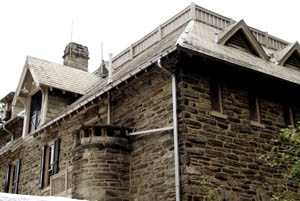 At the furthermost corner of Fairmount Park, the former estate of John and Lydia Morris is run as a public arboretum, one of the two or three finest in North America.
At the furthermost corner of Fairmount Park, the former estate of John and Lydia Morris is run as a public arboretum, one of the two or three finest in North America.
The University Museum: Frozen in Concrete
 Archaeology has long been at the center of Philadelphia culture. The University Museum of Archaeology, the largest of its kind in America. is a victim of success, stranded in a congested and overbuilt corner of town.
Archaeology has long been at the center of Philadelphia culture. The University Museum of Archaeology, the largest of its kind in America. is a victim of success, stranded in a congested and overbuilt corner of town.
Tree Huggers: Delaware Valley College
 Delaware Valley College is a curious mixture of farm school with scientific aspirations and a Jewish history, located in Doylestown, where New York City and Philadelphia meet,
Delaware Valley College is a curious mixture of farm school with scientific aspirations and a Jewish history, located in Doylestown, where New York City and Philadelphia meet,
Exit, Pursued by a Bear
 Its medical school consumes 75% of Penn's budget, causing a lot of difficulty for the rest of the University.
Its medical school consumes 75% of Penn's budget, causing a lot of difficulty for the rest of the University.
B. Franklin and Daylight Savings
 Daylight savings time was devised by Benjamin Franklin, but recently its value has been challenged.
Daylight savings time was devised by Benjamin Franklin, but recently its value has been challenged.
Philosophy Means Science in Philadelphia
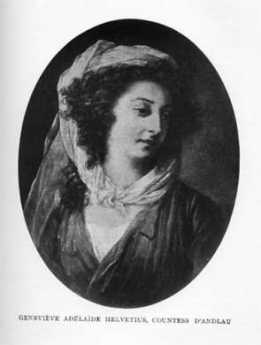 At least until he met Madame Helvetius, Benjamin Franklin displayed little interest in moral philosophy. His interest was in science, which was called natural philosophy in the Eighteenth Century. The American Philosophical Society is America's oldest and most prestigious society of scientific scholars. If investing is a science, the APS is good at that, too.
At least until he met Madame Helvetius, Benjamin Franklin displayed little interest in moral philosophy. His interest was in science, which was called natural philosophy in the Eighteenth Century. The American Philosophical Society is America's oldest and most prestigious society of scientific scholars. If investing is a science, the APS is good at that, too.
Vanishing Honey Bees
 Pollinators, mostly honey bees but including bats and hummingbirds, have been declining for fifty years. In 2008, the decline was sharply worse, a potential disaster for many flowering plants.
Pollinators, mostly honey bees but including bats and hummingbirds, have been declining for fifty years. In 2008, the decline was sharply worse, a potential disaster for many flowering plants.
Franklin Institute: Hawks and Galileo
 From May to Labor Day, 2009, a spectacular exhibit of the original instruments of Galileo is on loan from the Medici Museum in Florence. Hawks are nesting on the window sill, which you can watch from this page.
From May to Labor Day, 2009, a spectacular exhibit of the original instruments of Galileo is on loan from the Medici Museum in Florence. Hawks are nesting on the window sill, which you can watch from this page.
B. Franklin, Scientist
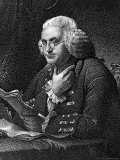 Kites are children's toys; going out in a thunderstorm is deliciously dangerous. We have thus been taught to regard Franklin's science as a lark, when in fact he largely discovered the nature of electricity and was regarded as one of the greatest scientists of his age.
Kites are children's toys; going out in a thunderstorm is deliciously dangerous. We have thus been taught to regard Franklin's science as a lark, when in fact he largely discovered the nature of electricity and was regarded as one of the greatest scientists of his age.
Barringer Crater in Winslow AZ
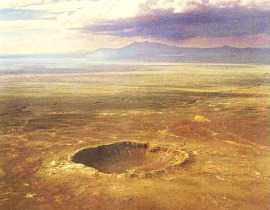
Geckos: Academy of Natural Sciences brings Mini Dinosaurs
 Philadelphia's Academy of Natural Sciences introduced the world to dinosaurs, and now introduces us to a miniature version.
Philadelphia's Academy of Natural Sciences introduced the world to dinosaurs, and now introduces us to a miniature version.
The University City
 Ben Franklin would scarcely recognize the college he created. It isn't named for him, but he probably would be concerned about how quickly it is changing.
Ben Franklin would scarcely recognize the college he created. It isn't named for him, but he probably would be concerned about how quickly it is changing.
Pyramid-Building, Greatly Simplified
 After several thousand years, building the Egyptian pyramids might turn out to be easier than we imagined.
After several thousand years, building the Egyptian pyramids might turn out to be easier than we imagined.
What's Different About Kosher ?
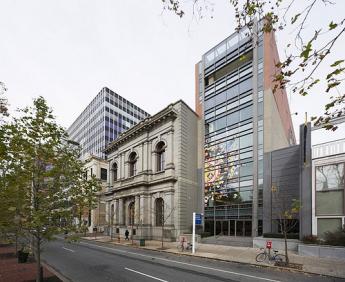 A recent conference at the Chemical Heritage Foundation examined the perplexing question of just what is signified by Kosher designation of food. Most of the curious audience were themselves Jewish.
A recent conference at the Chemical Heritage Foundation examined the perplexing question of just what is signified by Kosher designation of food. Most of the curious audience were themselves Jewish.
Philadelphia Chromosome
 Just about everybody has 46 chromosomes in every cell in the body. Some people have more than that: they have the Philadelphia Chromosome.
Just about everybody has 46 chromosomes in every cell in the body. Some people have more than that: they have the Philadelphia Chromosome.
Lumpers In Constant Combat With Splitters
 The home dinner table is no longer the place most families teach the rules of conduct to each other, probably because of the invasion of homes by television. But there are places where friendly debate is still conducted and social issues are settled. In Philadelphia, newcomers are still taught what's what, in this manner.
The home dinner table is no longer the place most families teach the rules of conduct to each other, probably because of the invasion of homes by television. But there are places where friendly debate is still conducted and social issues are settled. In Philadelphia, newcomers are still taught what's what, in this manner.
Marcellus Shale Gas: Good Thing or Bad?
 There's a gold rush, in gas not gold, in Pennsylvania. What are the unintended consequences?
There's a gold rush, in gas not gold, in Pennsylvania. What are the unintended consequences?
Rara Avis
 The Academy of Natural Sciences is one of the great jewels of Philadelphia, and like the rest of the city, cringes from publicity but needs it badly.
The Academy of Natural Sciences is one of the great jewels of Philadelphia, and like the rest of the city, cringes from publicity but needs it badly.
Atlantic City, Brigantine and the N.I.H.
 Great scientists in crowds look and act pretty much like everyone else.
Great scientists in crowds look and act pretty much like everyone else.
Whither Alzheimer?
 Individuals over 80 are increasing faster than any other age group. And so, their main disease is the fastest growing disease.
Individuals over 80 are increasing faster than any other age group. And so, their main disease is the fastest growing disease.
Joseph Priestley, Shaker and Mover
 The father of the science of chemistry was also the founder of the Unitarian Church in America.
The father of the science of chemistry was also the founder of the Unitarian Church in America.
Joseph Priestley of Northumberland, PA
 If asked to name the residence of Joseph Priestley, the Father of Modern Chemistry, most people would not think of Northumberland, PA.
If asked to name the residence of Joseph Priestley, the Father of Modern Chemistry, most people would not think of Northumberland, PA.
Three-Mile Island
 An ominous-looking nuclear energy plant developed some sort of difficulty, a few miles from the State Capital of Harrisburg. The direct effects were minor, but the political and psychological ones have endured for half a century.
An ominous-looking nuclear energy plant developed some sort of difficulty, a few miles from the State Capital of Harrisburg. The direct effects were minor, but the political and psychological ones have endured for half a century.
Thomas Say
 Thomas Say's portrait hangs in the Ewell Sale Stewart Library at the Academy of Natural Sciences in remembrance of his love of bugs and passion for the Academy.
Thomas Say's portrait hangs in the Ewell Sale Stewart Library at the Academy of Natural Sciences in remembrance of his love of bugs and passion for the Academy.
Elias Durand
 After first fighting in the Napoleonic wars, a French ex-pat brought a European flare both to Pharmacy and the study of Botany in the United States.
After first fighting in the Napoleonic wars, a French ex-pat brought a European flare both to Pharmacy and the study of Botany in the United States.
Ball Lightning, Regular Lightning, and B. Franklin
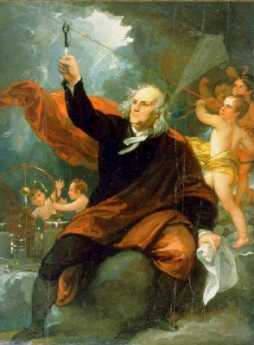 Knowledge about ball lightning is as dismal today as Franklin found the state of knowledge about regular lightning in 1752. Let's put ourselves in his shoes.
Knowledge about ball lightning is as dismal today as Franklin found the state of knowledge about regular lightning in 1752. Let's put ourselves in his shoes.
Nanoparticles: The Dwarfs are Coming
 A lot of basic science will have to be revised when we fully understand what happens to particles after they get small enough.
A lot of basic science will have to be revised when we fully understand what happens to particles after they get small enough.
Evo-Devo
 The Franklin Institute has been making awards for scientific achievement for 188 years, long before the Nobel Prize was invented. The seats are all reserved before the meeting notices are even mailed.
The Franklin Institute has been making awards for scientific achievement for 188 years, long before the Nobel Prize was invented. The seats are all reserved before the meeting notices are even mailed.
Bill Gates Gets a Medal
 The 2010 Bower Award was given to William Henry Gates, III by the Franklin Institute of Philadelphia. Although he might not agree, his life raises the topic of incentives.
The 2010 Bower Award was given to William Henry Gates, III by the Franklin Institute of Philadelphia. Although he might not agree, his life raises the topic of incentives.
American Chestnut Trees
 Scarcely a century ago, American Chestnut trees were a quarter of all trees in America. Now, they are almost all gone, but a thousand volunteers are trying to rescue them.
Scarcely a century ago, American Chestnut trees were a quarter of all trees in America. Now, they are almost all gone, but a thousand volunteers are trying to rescue them.
What's a Ribosome? Who is Joachim Frank?
 The Franklin Institute has picked out Joachim Frank as a life scientist of great eminence. If you don't know what a ribosome is, it's time you did.
The Franklin Institute has picked out Joachim Frank as a life scientist of great eminence. If you don't know what a ribosome is, it's time you did.
Bring Your Own Hammer
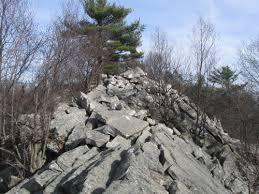 Pennsylvania has 120 State Parks, but this is a Bucks County Park. The exposed bedrock is in an eight-acre park of great big boulders, a few of which chime when you strike them. The rest just give out a clunking noise.
Pennsylvania has 120 State Parks, but this is a Bucks County Park. The exposed bedrock is in an eight-acre park of great big boulders, a few of which chime when you strike them. The rest just give out a clunking noise.